Major publications release their updated “MLB ballpark rankings” every year before Opening Day. At the risk of taking this too seriously, how can you do that before seeing any games in 2024 when two parks underwent significant renovations in the offseason?
I get mildly annoyed by the clickbait on this topic, because this is my thing. I’m obsessed with ballparks. I’ve not only seen games at every MLB park multiple times; I’ve seen games at every MLB park from a variety of seating areas to get the most comprehensive possible experiences. At this point, I’ve seen almost every part of every MLB park. I go to all games as a fan (and all photos are my own unless noted otherwise), so I have never received a press pass from the team or free tickets. I outline why I do this and why I think the ballpark warrants such examination here.
In 2018 and 2019, I ranked, rated, and reviewed all MLB ballparks in a long-form piece, but a shorter (shorter, not short!) refresher is in order after revisiting them again this year and throughout the 2020s. Some rankings have changed.
That piece outlines the methodology and criteria extensively, but here are the five broad categories with subcategories equaling 200 points, before being divided by 2 and adjusted for a curve and possible bonus points:
- Setting (x/20):
– Locale (x/5), Accessibility (x/5), Neighborhood Local Scene (x/10) - Architecture & Aesthetics (x/65):
– Exterior Design/Aesthetics (x/20), Interior Aesthetics/Visuals (x/40), Concourse Aesthetics (x/5) - Functionality & Essentials (x/50):
– Sightlines: Field Proximity (x/15), Sightlines: Seating Geometry (x/5), Seat Comfort: (x/9), Concourse Functionality (x/15), Scoreboards/Tech: (x/6) - Amenities & Features (x/50):
– Concessions: Food Variety (x/5), Concessions: Food Quality (x/5), Concessions: Craft Beer/Other Drinks (x/5), Social Spaces: Accessible Restaurants, Destination Bars, Sitting Areas, Social Gathering Areas (x/10), Premium Seating/Clubs (x/9), Historical Exhibits, Memorabilia, Art, and Other Displays (x/10), Kids Areas/Other Entertainment (x/6) - Atmosphere, Vibe, & Policies (x/15):
– Fan Support/Attendance (x/5), Ballpark Traditions/Gameday Presentation (x/5), Ballpark Policies/Staff (x/5)
I look at the totality of what the ballpark has to offer, proportioned appropriately. Although, I am not captive to the ratings system if something doesn’t feel right, hence the bonus points. Here’s the Coors Field’s “scorecard,” to take a broadly well-regarded and non-polarizing park, to see the ratings system in practice.
I know, it’s a lot; it’s wonky! All of that being said, I think there is one element that encompasses almost all of these categories.
If I could distill the answer to “what makes a ballpark great?” to one aspect, it is that a great ballpark represents its team, city, and/or region. All ballparks should pass the, “Where Am I? test.” From downtown views and local grub to team historical references and other regionally-inspired amenities, that sense of place is the overarching key.
I’d also add that sightlines matter. So much attention is given to things like pretty backdrops and food, but the baseball-watching quality of these venues is the primary concern. Although, there’s not much differentiation between modern-day ballparks in field proximity.
In addition, I’m an urbanist at heart, so I strongly prefer ballparks integrated with the city fabric and all of the positives that come with that — namely, the vibrant surrounding pre-and post-game bar/restaurant scenes and scenic views beyond the outfield.
Even with rigor, this is obviously still a subjective exercise. Fans value different things. You may not care that a ballpark serves high-quality local food. You may be in the minority and prefer ballparks surrounded by a sea of parking in suburbia. That’s all cool. I in no way hold myself out as some sort of final arbiter of stadia!
This is also a comparative exercise, and with billions of dollars poured into ballparks across America since 1990, the standards are relatively high – there are only two “bad” ballparks in MLB. Ranking in the bottom tercile is no slight. So, I’ve grouped all 30 ballparks into different tiers within the rankings. It’s helpful to focus on the “rating” and the general company a ballpark keeps.
Without further ado, here are my 2024 MLB ballpark rankings and ratings.
F Tier: The Two “Bad” Ballparks
These are universally regarded as MLB’s two worst parks. I agree. There’s no getting around the inadequacy of these structures both aesthetically and functionally, as these are the only two MLB stadiums that genuinely warrant replacement. Although, there’s considerable daylight between #30 and #29 in degree of inadequacy.
30) Oakland-Alameda County Coliseum (1966), Oakland Athletics: 43.5
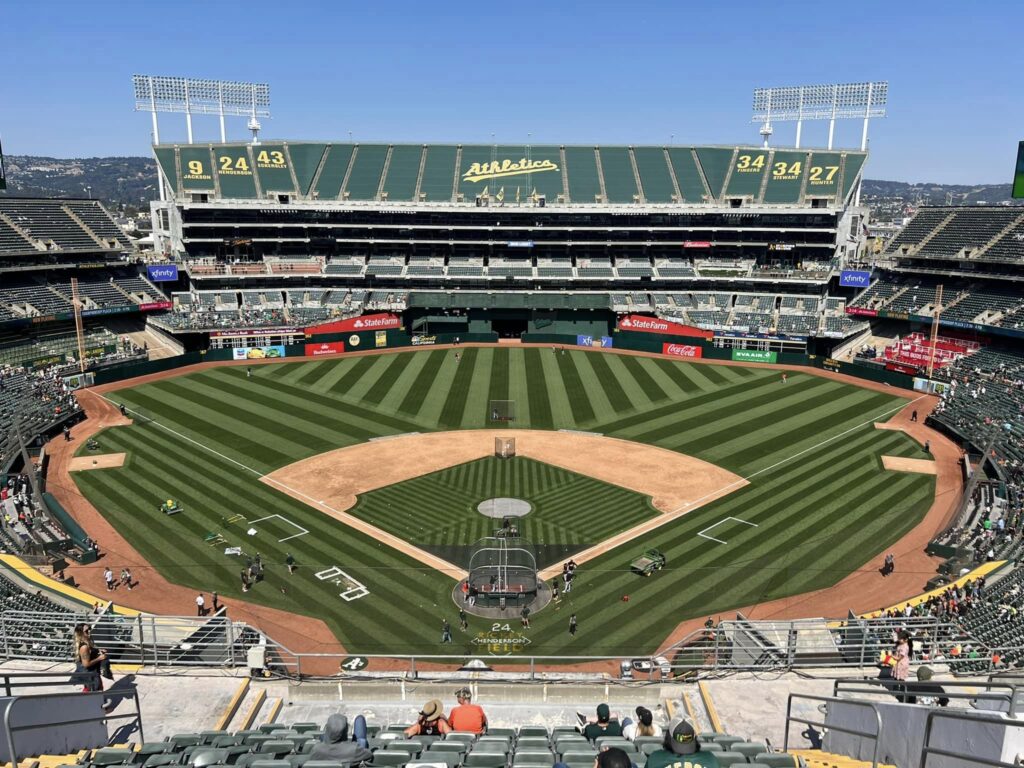
I’m not going to go down dead horse boulevard and kick the old gal while she’s down. Everyone knows Oakland’s stadium is terrible.
But even in the 2010s when the team was trying, I never thought this ranking was a close call. Other than being an open-air ballpark with natural grass and having tremendous accessibility via BART, baseball’s last dive bar is considerably worse than #29 in every facet.
I will say that if you’re in Oakland, I’d encourage you to see this place before it closes. It’s so lacking in frills almost to the point of novelty, like going back to the 1980s. There’s nothing else like this left in the major North American sports.
29) Tropicana Field (1990), Tampa Bay Rays: 54.5

Tropicana Field’s flaws have been extensively documented. As MLB’s only stationary dome, it takes the crown as baseball’s ugliest ballpark. With artificial turf, a drab interior aesthetic with no natural sunlight, and exterior materials that evoke a Walmart distribution warehouse, Tropicana Field feels more mausoleum than ballpark.
It’s not particularly functional, with fairly narrow concourses closed from the field, old seats, outdated videoboards, and of course, the infamous ceiling catwalks. And it’s located in the wrong place, a difficult drive for fans in Tampa and most of the metro area.
All of that being said, here’s the thing about Tropicana Field: they try.
Given the limitations of the structure, the Rays have put a lot of time and money into making the amenities and overall fan experience otherwise respectable in the last 15 years. It was also retrofitted as baseball-only facility in 1998, so the sightlines are decent.
Consider: (a) St. Petersburg’s Edge District makes for a vibrant pre-and post-game local scene; (b) the centerfield rotunda is neat; (c) the dome lights are cool; (d) the food and beverage department is underrated; (e) the Rays Touch Tank is a unique amenity; and (f) Rays’ history is appropriately celebrated throughout the park. Most of all, Tropicana Field scores high in the “memorability factor,” as there is nothing else like this in MLB.
Ultimately, Tropicana Field is still far and away MLB’s second worst ballpark, but it has redeeming qualities.
D Tier: The Barely Passable Ballpark
28) Angel Stadium (1966), Los Angeles Angels: 68
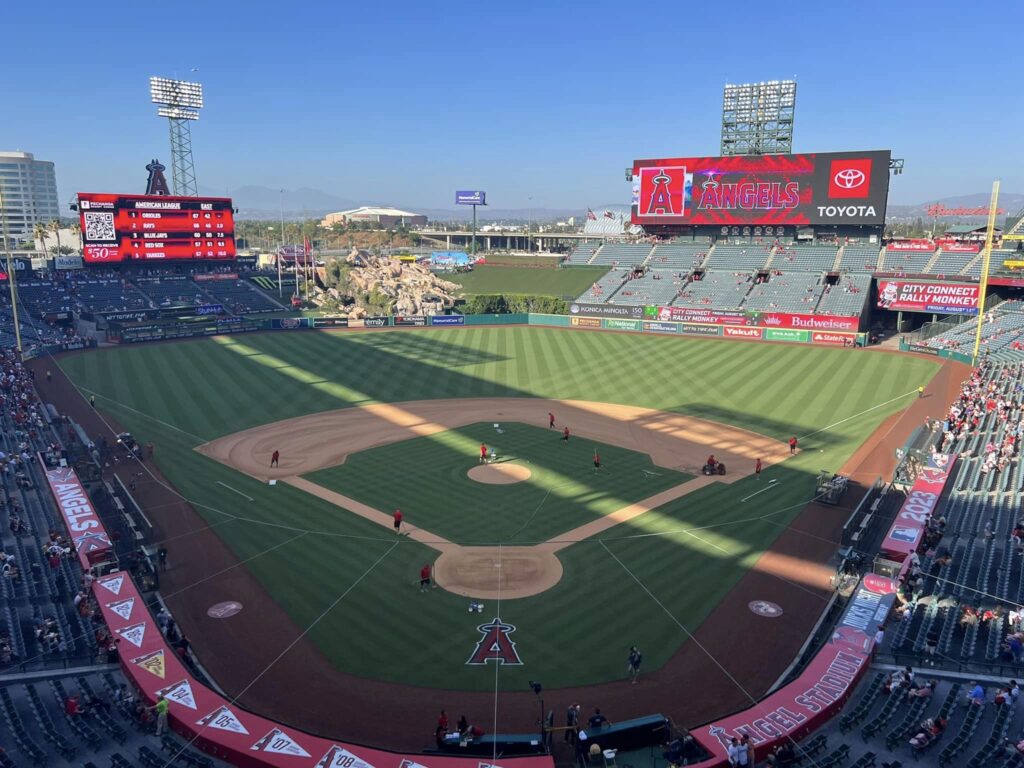
After being enclosed to accommodate football and converted into a multiuse facility in the early 1980s, Angel Stadium was the only multipurpose MLB stadium to be renovated instead of replaced during the post-1990 ballpark-building boom.
However, 1) those 1997-98 renovations that transformed Angel Stadium back to baseball-only status didn’t go far enough, with remnants of the stadium’s multipurpose existence still apparent inside and out; and 2) Angel Stadium hasn’t been properly maintained in the 25+ years since those renovations.
Angel Stadium is a quintessential suburban stadium surrounded by parking lots, and that’s always cause for demerits. Outside, while new parks of the era received tasteful neoclassical treatment, Angel Stadium got paint on concrete. The grand entrance is a touched-up version of the old façade plastered with gimmicks. Inside, you can still see the shell of the multipurpose grandstand, characterized by tired, disconnected outfield stands with a poorly integrated faux rock geyser.
All of the cosmetic changes make it look like the Tammy Faye Baker of ballparks: instead of aging gracefully, they slapped a bunch of makeup on it, which in turn has not aged well. It looks both tacky and dated.
The mountain views beyond left and center field, however, are underrated.
Objectively, Angel Stadium falls short across the board compared to the post-1990 parks. The sightlines have plenty of awkward viewing angles and overhang obstructions. The concourses are generally too narrow, among other issues. The seats are quite worn. From the food and drinks to the social spaces and clubs, the amenities are poor across the board. Not even a kids’ area. Even compared to a Tropicana Field, Angel Stadium doesn’t have any extra frills.
It all adds up to a wholly unmemorable stadium experience that’s below average in almost every facet, even if there’s nothing startlingly inadequate like at the parks in Oakland and Tampa. I’m calling this one barely passable.
A dramatic mixed-use development project was proposed for the site in the past, and Angel Stadium will either be renovated (again) or replaced in the not-so-distant future.
C Tier: Decent Ballparks, With Flaws
These ballparks have plenty of good qualities, but they have significant flaws that outweigh their strongpoints. Three out of five of the below are due for renovations or replacement. One other is multipurpose facility renovated into a ballpark.
27) Chase Field (1998), Arizona Diamondbacks: 72.5
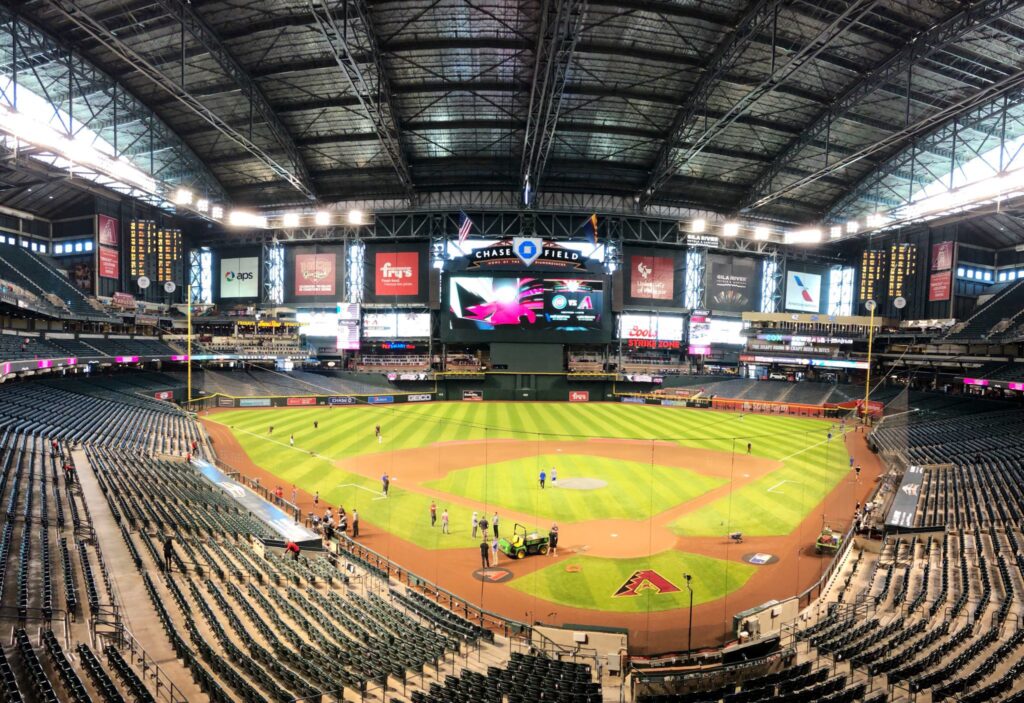
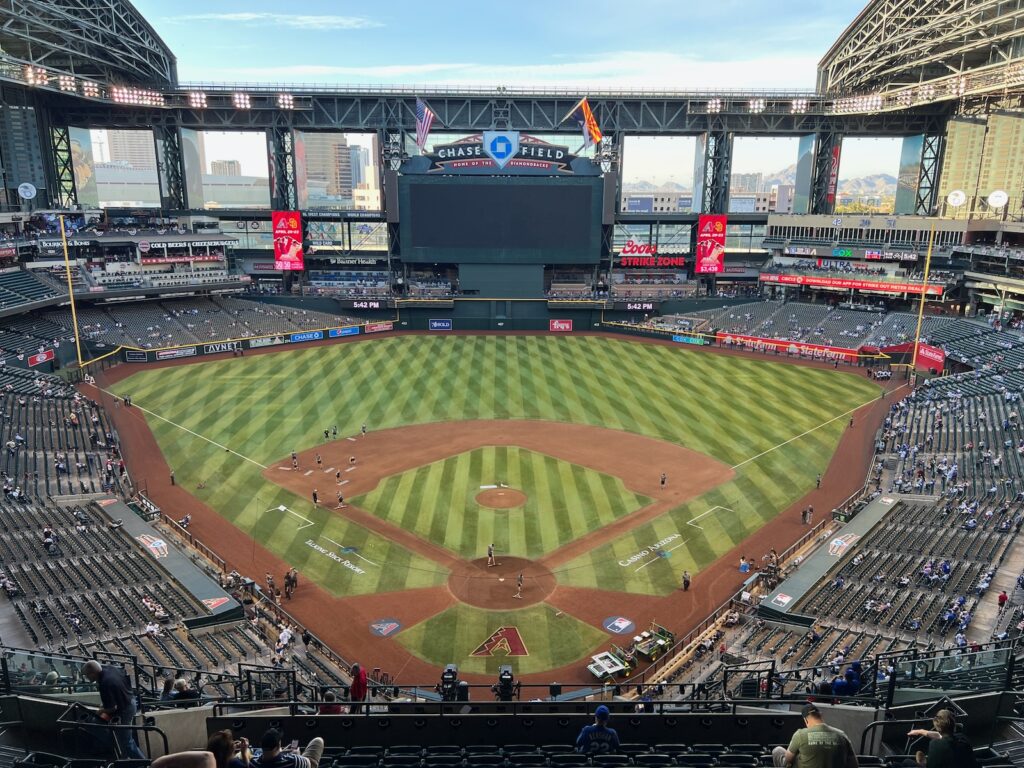
As the first baseball-only stadium with a retractable roof, Chase Field is all function over form, geared toward pumping in air conditioning to make baseball work in the desert. Often likened to an airplane hangar, it’s the least aesthetically attractive MLB ballpark of the post-1990 building boom, lacking much architectural intrigue.
Chase Field’s big and boxy exterior profile features terribly clashing architecture, typifying an era where inevitably modern retractable roof parks tried to be “retro.” Inside, Chase Field feels like watching baseball in a giant gym. Even when the roof is open, Chase Field feels bounded. When the roof is closed, almost no natural light is emitted into the building. And the cavernous upper deck screams outdated empty stadium.
With a dearth of significant enhancements over the years, Chase Field’s amenities have not aged well. Think mall-like concessions, pedestrian food quality, a poor craft beer selection, minimal social gathering areas, two aging outfield restaurants (although, at least a decent burger joint now occupies one of them), tired premium spaces at field level, and a worn club level. It all evokes an out-of-date 1990s shopping mall.
It’s also rife with behind-the-scenes technical issues. The roof can only be opened or closed when the stadium is empty due to a broken pulley (fan safety issue). The roof leaks. It’s made the local news rounds for grease fires in the kitchens, burst pipes, faulty scoreboard lights, and other issues.
Chase Field has some bright spots. It’s a downtown ballpark. There’s the pool. I love the murals in the rotunda celebrating natural Arizona landmarks. Crucially, it’s still pretty functional for baseball viewing, with superb seating geometry and an open main concourse without interruptions in field visibility. It’s also one of those parks where it really matters when you go: on a day game in early April with the roof open, the experience is much better.
The Diamondbacks desire a new ballpark or a top-to-bottom renovation to Chase Field.
26) Guaranteed Rate Field (1991), Chicago White Sox: 74
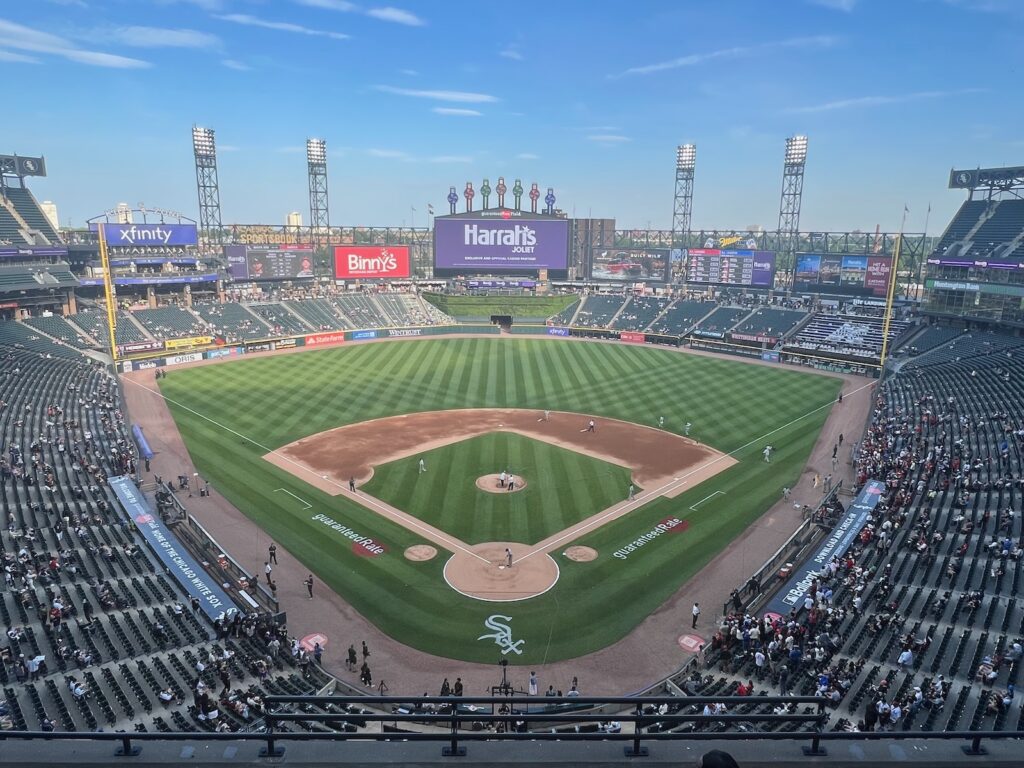
Just barely missing the retro-classic trend ushered in by Camden Yards (1992), the White Sox stadium (1991) usually falls near the very bottom of ballpark rankings. But as any ballpark enthusiast will tell you, Chicago’s South Side ballpark has gotten so much better after over 20 years of periodic renovations.
Yes, inside and out, little about GRF makes any pretense of being aesthetically attractive. With an enclosed, ad-plastered outfield facing away from Chicago’s skyline, GRF has little character and absolutely no visual sense of place. But compared to some busy, disjointed, and gimmicky retro parks, there is a certain coherence and simplicity about its symmetrical interior lines that just rub me the right way.
GTF’s amenities and fan-friendly features compare pretty well: (a) good food, (b) top-5 ballpark for craft beer, (c) The Craft Kave (now known as “Leinenkugel’s Craft Lodge”), one of baseball’s best social spaces, (d) multiple lounges and bars littered around the main concourse, (e) statues adorn the outfield concourse, and (f) a kids’ area focused on baseball activities. And don’t forget the exploding scoreboard and the pinwheels, now equipped with state-of-the-art tech to match its reputation.
However, GRF is still rife with flaws beyond the nondescript aesthetics, because there are plenty of structural issues that can’t be fixed. The upper deck is still high, steep, and far from the action. Cumbersome ramps are still required for vertical circulation; exploring the park is a chore. And it’s still a “parking lot stadium,” even if accessibility is superb via the Red Line.
Finally, while inconsistently enforced, the policy restricting upper deck ticket holders to that level, meaning they can’t access the amenities on the main concourse, is deplorable. I didn’t see it enforced in 2024, but it appears to still be on the books.
But GTF doesn’t deserve to be associated with the two “bad” stadiums in Oakland and Tampa, which I see far too often. The White Sox desire a new ballpark in the South Loop just south of Downtown Chicago.
25) Rogers Centre (1989), Toronto Blue Jays: 74.5
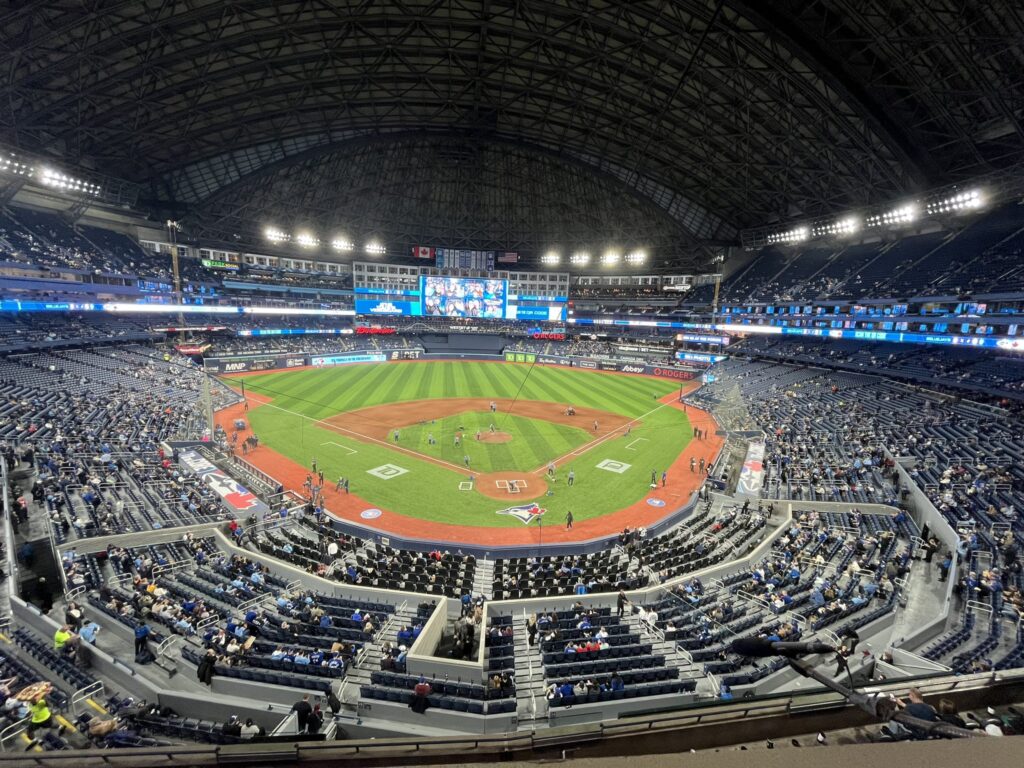
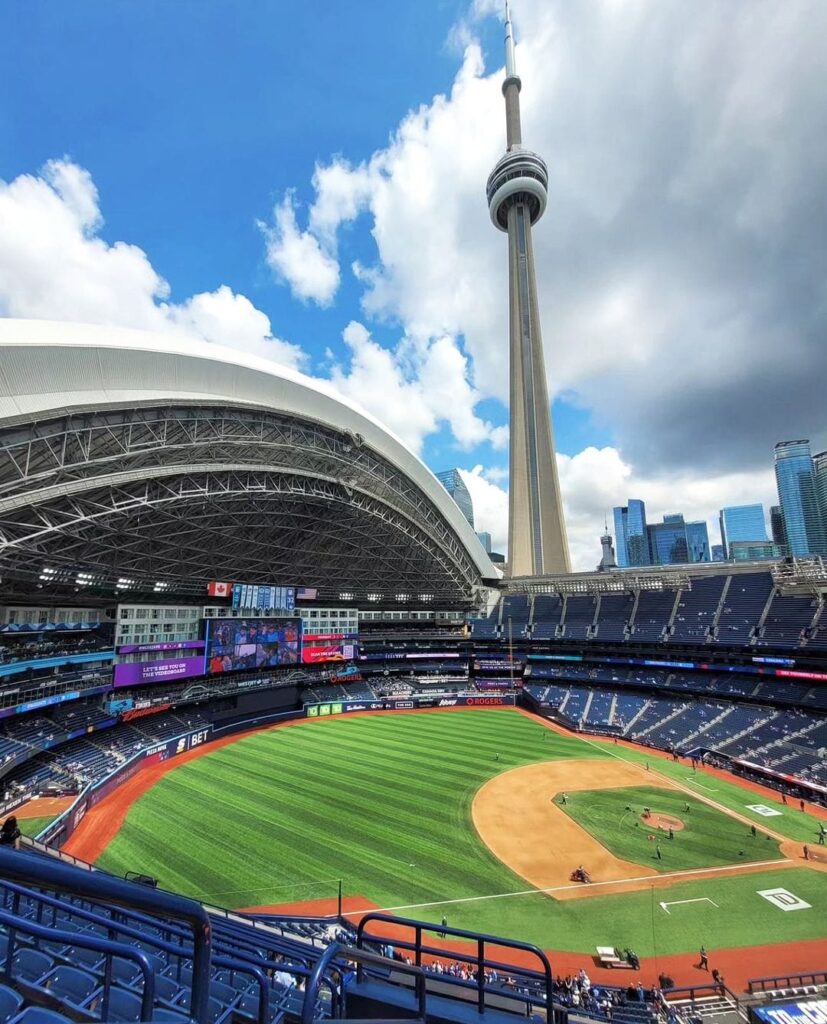
As North America’s first fully functional retractable roof stadium, the multipurpose Rogers Centre (SkyDome) was a modern marvel when it opened, but it was outdated by the 21st century.
That all changed after $400 million in renovations in 2023 and 2024, transforming it from “stadium” to “ballpark.”
The lower bowl was completely rebuilt to improve sightlines, with the pitch degree increased and grandstands down the lines properly oriented toward the infield. All seats dating back to 1989 were replaced. A state-of-the-art videoboard sits in center field. The food and beverage game, formerly MLB’s worst, has improved. Premium seating was added at field level, and three new premium clubs will debut later this summer.
Most significantly, the Jays built a sprawling, multi-level “Outfield District” consisting of eight bonafide social spaces in five “neighborhoods,” with so many awesome SRO spots as well. The outfield is redone top to bottom. Overall, phenomenal renovations. And SkyDome still has its urban location in one of the world’s greatest cities. Don’t forget about the center field hotel, one of baseball’s neatest landmarks!
So why does SkyDome sit at #25? For one, the architecture is still from another era – the exterior looks like a concrete bathtub and feels like a fortress. Inside, no natural light is emitted when the roof is closed, in what evokes an arena, not a ballpark. When the roof is open, the ballpark has a notably better personality with views of the CN Tower (which are incredible; the tower feels omnipresent), but the outfield is still enclosed, unlike superior retractable roof ballparks.
Most of all, there are still too many remnants of its 1989 design from a functional standpoint. Namely, the comically steep upper deck is too high and far from the field, housing over 10,000 of baseball’s worst seats. Huge flaw! In addition, ramps (no escalators/few stairs) are still required for circulation, another callback to a bygone era. Also, in its transformation to “ballpark,” SkyDome is still missing any celebration of team history through exhibits/memorabilia/plaques/statues/anything, something seen to some degree in all 29 other parks.
Ultimately, SkyDome now offers a respectable fan experience comparable to many mid-tier parks on this list, but there’s only so much lipstick you can put on the outdated superstructure.
24) American Family Field (2001), Milwaukee Brewers: 75

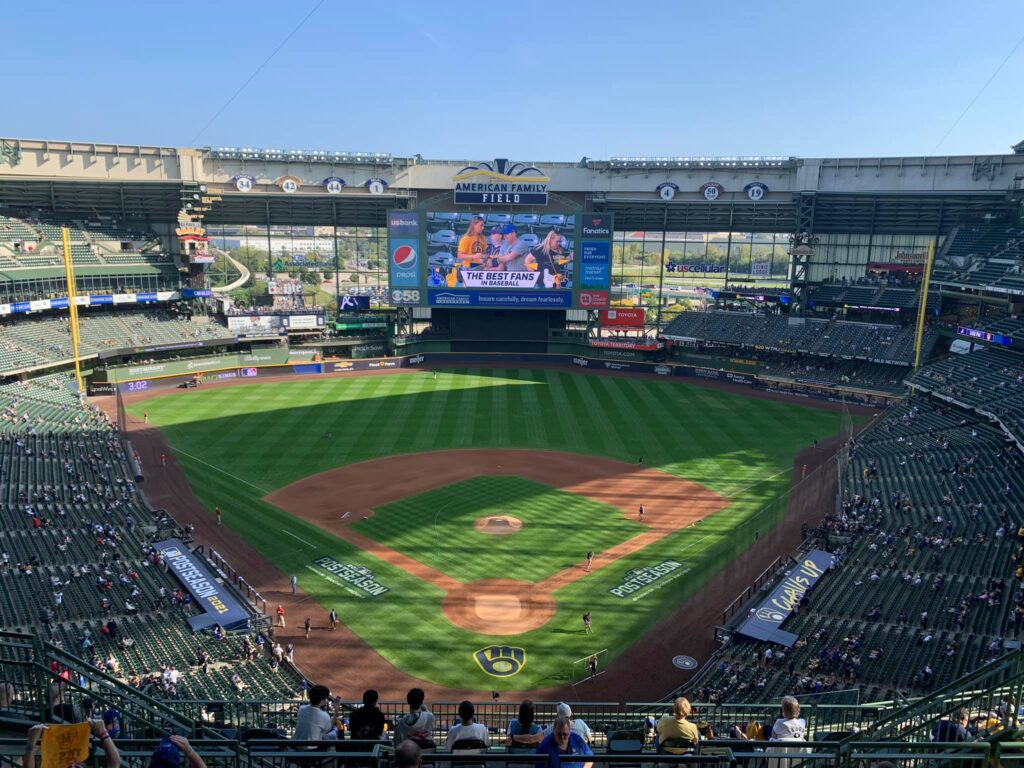
Notable for its fan-shaped retractable roof, I’ve always been particularly harsh on the artist formerly known as Miller Park, which is curious given how much fun I have here. So much of the intangibles of a Brewers game—the awesome fans, the Milwaukee vibe, the unique ballpark traditions like the Sausage Race—are delightful. And that counts for a lot. But Miller Park falls short in virtually all other facets.
The tailgating experience is fantastic, but Miller Park is surrounded by parking lots in all directions without anything of interest within walking distance, and I’m always on team downtown baseball. I don’t like the exterior’s gargantuan profile that screams “small town trying to be prime time” or its red brick facade, out of place for the non-urban setting, city, and roof technology. Strong Elroy Jetson’s hat/Queen Victoria’s dress vibes! It screams Steampunk.
Inside, the park feels dramatically overscaled. Even when the roof is open, the park feels drab and enclosed. When the roof is closed, outfield panels let in no natural light. Although, the glass above the upper deck allows some light in. Compared to retractable roof parks in Seattle and Houston, there is no visual sense of place here whatsoever, and it particularly lacks intimacy for only 42,000 seats. Overall, the architecture inside and out does not reflect the city, independent of its unwieldy aesthetics.
Miller Park isn’t a particularly functional building for watching baseball. All modern-day ballparks have upper decks too high and pushed back, but Miller Park is the worst offender, with four decks and little overhang. The seating geometry can be problematic. Seats in the upper deck lack cupholders, a rarity. The main concourse is difficult to navigate with many confusing horizontal discontinuities. The outfield concourse is barren and narrow.
There are some bright spots—good local food, a massive craft beer wall, the new left field brewery, and a (*checks notes*) new virtual golf zone—but the amenities are merely average overall.
This is a comparative exercise—all modern-day baseball-only venues are enjoyable, including Miller Park—but I just don’t see how Miller Park compares well objectively speaking. The Brewers desire $448 million in renovations.
23) Globe Life Field (2020), Texas Rangers: 76.5
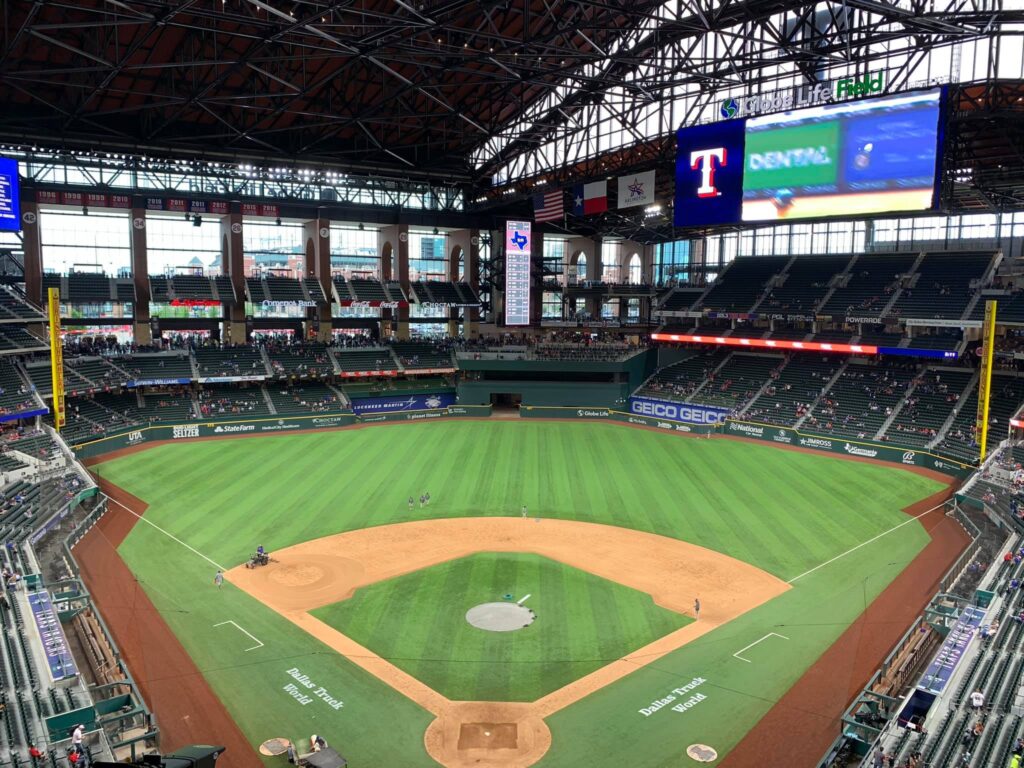

Globe Life Field has plenty of redeeming qualities, but it is the most disappointing new MLB ballpark since New Comiskey in 1991, combining many of the worst trends in stadium design.
First of all, GLF follows the Truist Park (Atlanta) mallpark model of building an almost offensively generic stadium and attaching it to manufactured mixed-use development. Prioritizing utility over charm, dubbed “more Events Center than Ballpark,” GLF has no design goal beyond generating revenue and fabricating experiential aesthetics, with little attention paid to timeless visual aesthetics.
The much-maligned exterior façade ranges from ugly to pedestrian, lacking any distinctive design cues. Think warehouse attached to a suburban office park. Even in its best spots, this could be an expansion team’s ballpark in “Anywhere, USA.”
The interior is totally nondescript, bereft of any signature elements, interesting views, or overarching aesthetic vision. Zero personality. The roof also only opens at the top like a sunroof, unlike Milwaukee, Miami, or Arizona which open at the top and have retractable outfield panels, or the far superior designs in Seattle and Houston where the roof retracts over the entirety of left/center field showcasing skyline views. The sole bright spot are the archways on the left field concourse, but crucially, they not visible from the seating bowl.
Even for an aesthetically uninspired mallpark, GLF isn’t even a fun mallpark for the average fan, because most of the amenities are concentrated toward premium.
While they have improved in the mid-2020s with Hurtado and Whataburger, the food options are middling. The craft beer selection is below average. The park mostly lacks destination social spaces throughout the concourses. The team historical tributes aren’t extensive. The Rangers point to Texas Live! outside the park, but there needs to be more within GLF’s confines.
Perhaps most importantly, GLF has the most fan-unfriendly seating bowl design in baseball, where fans cannot access the entirety of the lower bowl and lower bowl concourse in between the foul poles without an appropriate premium ticket! That’s even worse than Yankee Stadium, which has been much-maligned on this point.
On the plus side, GLF is functional, and I don’t mean that as an insult. Climate control. Excellent sightlines. Wide seats. Not one, but two wide 360-degree concourses open to the field. Top-of-the-line tech. GLF’s superior functionality carriers a lot of weight, but it has no soul.
Ultimately, GLF is defined by 1) its mallpark philosophy, 2) unremarkable aesthetics inside and out, 3) mediocre amenities for regular fans, and 4) a fan-unfriendly seating structure designed to exclude regular fans from the lower bowl unlike ever before.
Sure, fans are now out of the heat, but at what cost? $1.2 billion, actually! That’s a lot of money for air conditioning and a structure that has less character and is less fan-friendly than its predecessor!
B Tier: The Good Ballparks
The B and B (+) Tiers consist of parks ranked #22 to #7. If you look at the “ratings,” there isn’t a ton of daylight between #22 to #7. However, I’m further separating the six ballparks below within the B Tier as merely “good” ballparks versus “great” ones. The pros outweigh the cons, but the six ballparks below have some flaw(s) that fully separate them from the great ballparks.
22) loanDepot Park (2012), Miami Marlins: 79.5


Despite receiving positive reviews upon opening, Marlins Park is generally considered a bottom 5-10 ballpark for issues that have little to do with the actual ballpark.
Bitterness surrounding unrelated issues—like the stadium’s dodgy financing scheme, the Marlins organization’s ineptness, and the sparse attendance—translated to antipathy toward the ballpark itself. People conflate the Marlins franchise with Marlins Park. That makes no sense.
However, I’ve downgraded Marlins Park’s rating as of late for two reasons:
1) Attendance issues are sufficiently dire to affect the essentials of the ballpark experience, with the stadium operations routinely at 1/3rd capacity. The upper deck, for example, is only open on Opening Day.
2) Jeter-era no-fun alterations. Replacing the home run sculpture with a generic party deck, the pool nightclub with an overpriced lounge, and the fish tank with ads represents the new homogeneity of ballparks to a tee.
Regardless, I still think the building itself is architecturally underrated, even if it doesn’t fit in the Little Havana neighborhood (and Marlins Park’s location alone is a big drawback). Design-wise, Marlins Park stands alone in baseball history as the only contemporary MLB ballpark in the 21st century sense of the word.
On the outside, Marlins Park conceptually captures sea merging with land, with an amalgam of deep blue glass, white stucco and steel, unadulterated concrete, and sparkling silver aluminum. With graceful fluidity in form, it’s an abstract expression of Miami. Marlins Park has one of my favorite exteriors, a big deal in my book as an architecture nerd.
The refreshed interior feels modern yet subdued, highlighted by the sleek white facade and attractive greenery. The retractable left field panels reveal surprisingly beautiful views of Brickell/Downtown Miami. I also adore the contemporary baseball-related artwork sprinkled throughout the concourses. Overall, Marlins Park scores highest in “architecture and aesthetics” on my scorecard among retractable roof parks.
Marlins Park is particularly functional, with a wide, open main concourse without interruptions in field visibility and excellent sightlines for a post-1990 ballpark. The park’s amenities aren’t as fan-friendly as they should be—sparse crowds are partly to blame—but scrumptious Latin food options, a new beer hall, a new Marlins Museum, and the Bobblehead Museum are highlights.
In sum, I agree that Marlins Park is a bottom-10 ballpark experience, mostly because a ballpark this empty just isn’t a fun one. Attendance this poor has operational effects beyond a listless atmosphere. But Marlins Park’s dazzling contemporary architecture and aesthetics make it worth a visit.
21) Great American Ball Park (2003), Cincinnati Reds: 80.5
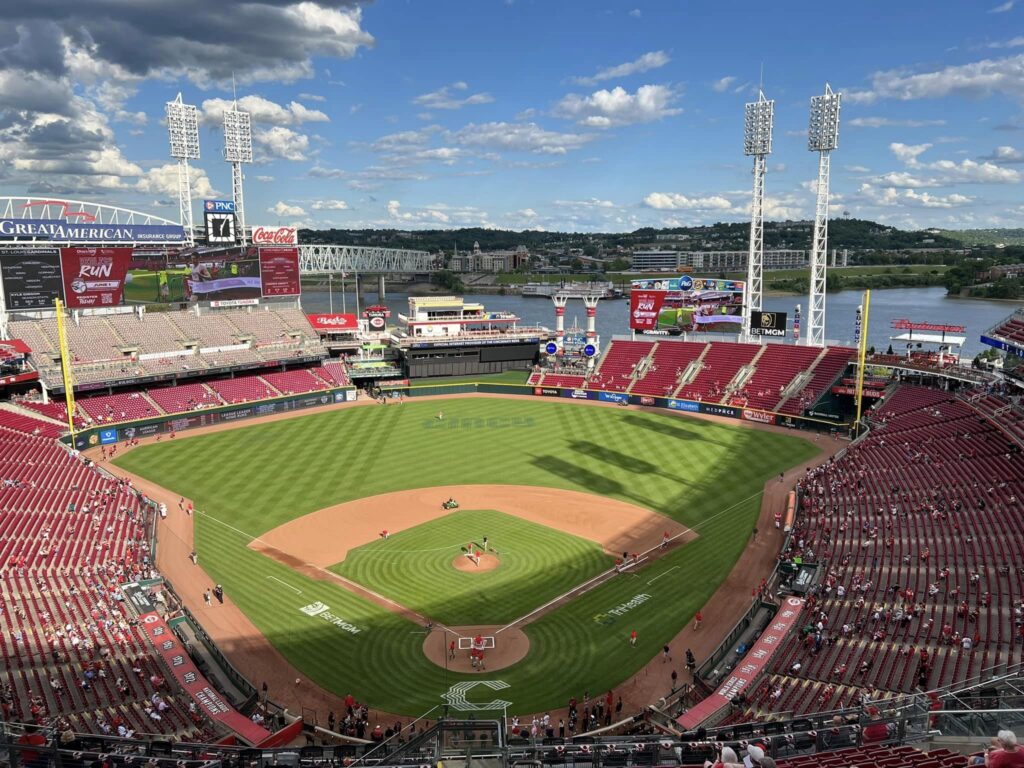
While Great American Ball Park has plenty to offer, it has received mixed reviews for a 21st century ballpark, generally landing in the lower-mid tier to bottom 10 of most ballpark rankings.
Equipped with a downtown riverfront setting, GABP represents the single biggest ballpark missed opportunity of our generation, because the execution was botched. I don’t want to totally put that on the architects, because other stakeholders had significant influence over the final product.
GABP has my least favorite interior aesthetics for a ballpark without a roof. While it was an admittedly complex and ambitious assignment given the variety of elements they tried to incorporate, how do you have the riverfront and the skyline, yet have good views of neither?
The underlying design is disjointed and fragmented. In the outfield, riverfront views are blocked by oversized seating, clumsy signage, a new superfluous videoboard, the tackiest gimmicks in baseball, and an ugly black batter’s eye, leaving the park with little sense of place from most vantage points other than the top of the upper decks. If you look at some early renderings, GABP was much more open to its environs in the outfield.
In the infield, “The Gap” behind home plate is a well-intentioned concept that just doesn’t work in practice, giving GABP a real “split personality.” The Gap also got “filled” with suites and patios, diluting the architects’ original concept. It’s all just awful, with so much junk and kitschy stuff thrown in that distracts from the original concept of integrating the riverfront scenery/urban context. Ultimately, the interior is poorly integrated with Cincinnati’s urban and riverfront fabric, then tacks on a bunch of gimmicks that further limit the visual appeal.
The interior design and visuals are obviously going to comprise the bulk of any analysis, but if you’re willing to look past that (and it’s subjective, obviously), GABP has a lot of things going for it.
The surrounding downtown local scene of bars and restaurants has greatly improved. Crosley Terrace with statues of Reds legends in action behind home plate is awesome. I love the art deco bas relief outside, even if the exterior architecture is a mixed bag overall. The seating geometry is excellent. While not perfect, some of the amenities are superb: (a) local food, (b) top-10 ballpark for craft beer, (c) the Kroger Fan Zone is one of baseball’s best ballpark kids’ areas and hangout spots for all ages, and most importantly, (d) the Reds Museum and Hall of Fame connected to the park is the absolute best of its kind.
Ultimately, the fan experience is solid, but purely design-wise, GABP is probably Populous’s biggest miss.
20) Minute Maid Park (2000), Houston Astros: 81
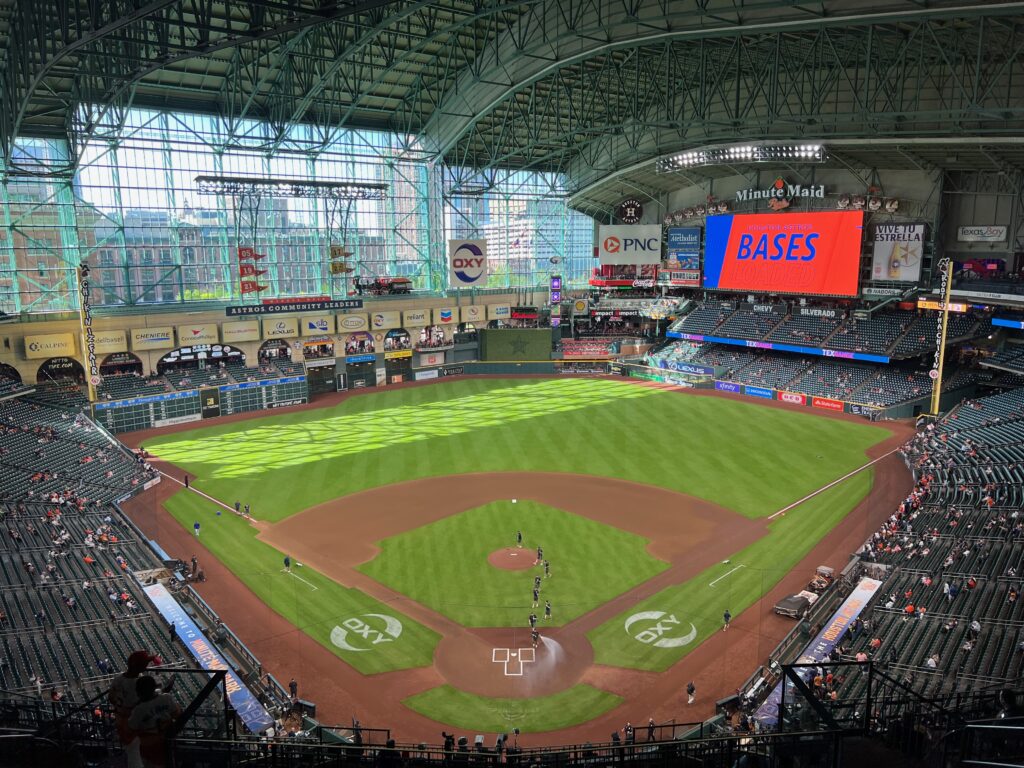

In what used to be one of the most underrated parks in baseball, Minute Maid Park has fallen the farthest on my list in the last decade plus. While the fundamentals are strong, I think the Astros have made a lot of changes that have actually worsened the fan experience.
To start with the positives, I still think Minute Maid Park is the model climate-controlled retractable roof park from a design standpoint.
I stress contextual appreciation of the site above all else, and the Astros took one element in the downtown community, the gorgeous red brick Union Station (old train station), and used it as the framework for the entire park. They also incorporated Union Station into the park through adaptive reuse. On the outside, MMP’s architecture mirrors Union Station, much like Camden Yards mirrors the B&O Warehouse. Even the retractable roof itself evokes the faded lacy ironwork of 19th century train sheds.
While commonly derided for its gimmicky choo-choo train and quirky dimension, the inside is even better. In a perfect application of context and theme to function, the sliding glass retractable roof tracks ingeniously serve as a mechanism for executing the train track aesthetic. And those gorgeous beige stone arches and the red brick Union Station, along with the Crawford Boxes and old-fashioned manual out-of-town scoreboard, tie it all together.
Most importantly, the low roof tracks allow for some of baseball’s best skyline views when the roof is open. The roof completely retracts off the seating bowl and in the outfield. It’s like a convertible, whereas other climate-controlled retractable roof parks are like sunroofs. When closed, MMP is about as attractive as the inside of an enclosed ballpark could be, strategically maneuvering natural light through the world’s largest sliding glass door.
Finally, MMP is fairly functional across the board, with some of baseball’s best SRO areas in the outfield, including a balcony extending over the field. The local food (El Tiempo and Killen’s BBQ) and Astros Hall of Fame concourse in left field are well done.
However, MMP has made a number of changes over the years, some major (believe it or not, I’m torn on the removal of Tal’s Hill, so not that) and some subtle, that I just hate. Since I’ve downgraded MMP park so much in the last decade plus, I feel the need to elaborate on the major ones:
1) The roof is almost never open nowadays, even when the weather is mild in April. And I mean that literally. Unless there’s an unprecedented cold front, the roof will be open ZERO times during the 2024 regular season! It was open ONE time each during the ’23 and ’22 regular season. I want to be clear: I’m not complaining about it being closed when it’s hot. No other retractable roof ballpark, including the one in Miami, leaves it closed with temperatures in the mid 70s! If I was super harsh, I could basically grade this as an indoor park at this point.
2) MMP’s interior aesthetic appeal has been nullified by clutter, namely the ads littered above the beige stone archways. It’s one thing to obscure more remote parts of the upper deck with 12 giant ads. It’s another matter to muddle your chief interior aesthetic asset with them. I understand the necessity of ads, but it’s too much. Compare the before (and when the park opened) to now.
3) Team Store overkill, displacing or ruining many of the park’s best features. A team store now occupies Union Station, formerly the “grand entrance” to MMP and MMP’s signature architectural feature. This would be akin to turning the entirety of the Jackie Robinson Rotunda at Citi Field into a team store and it no longer functioning as an entrance. In addition, team stores displaced a nice sit-down bar on the main concourse behind home plate, a restaurant in center field, and the kids’ area. It’s only one of three MLB parks to lack a kids’ area. MMP is near the bottom in amenities on my scorecard, because seemingly every space on the concourses is dedicated to selling merchandise, so there’s no room for anything else! I imagine it’s also why MMP comparatively lacks spaces to sit down or hang out on the concourses compared to 28 or so other parks, something that drives me nuts when I grab a bite with a big group before the game. No other park comes close to having this idiosyncratic problem where team stores take up so much real estate to detract from the overall experience.
I’ll stop there for this piece. Overall, MMP is an intriguing structure, but it used to be better.
19) Kauffman Stadium (1973), Kansas City Royals: 81.5
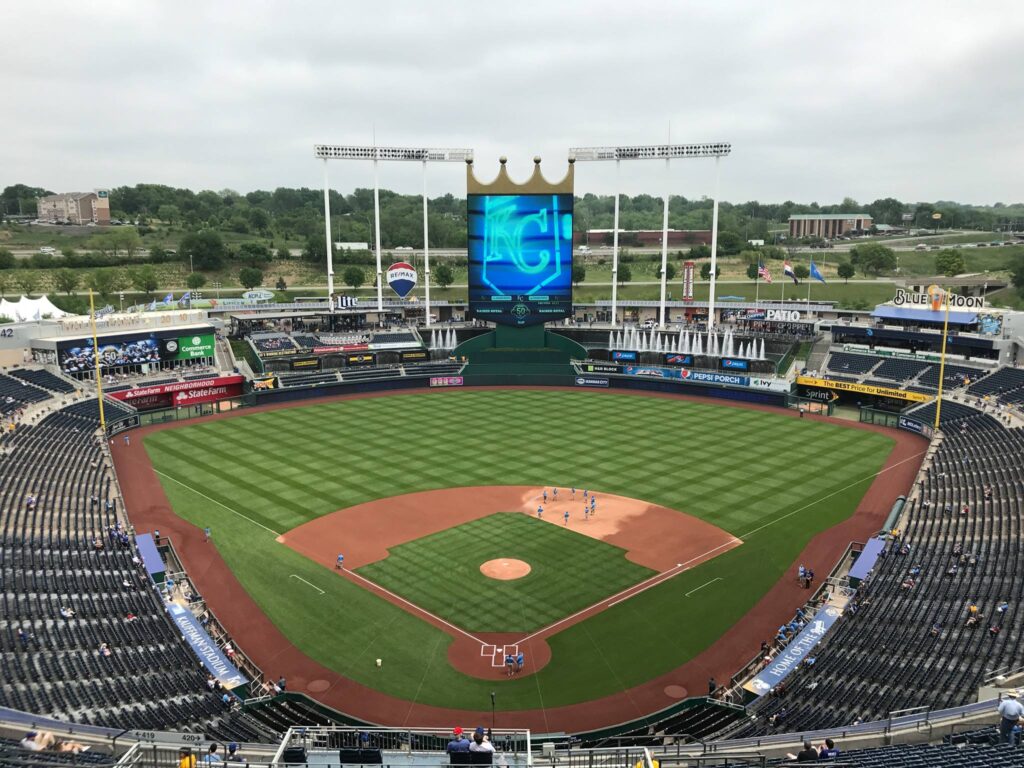
Praised as a 20th century classic for its clean, modernist lines and outfield fountains, my take on Kauffman Stadium is one of the site’s more controversial ones, as longtime ballpark enthusiasts generally place The K on the periphery of the top 10.
My rationale is twofold: 1) I didn’t like the aesthetic changes made to the outfield scene during the sweeping 2008-09 renovations, and 2) I still can’t get past the suburban setting.
1) The central appeal of old Kauffman was not only the fountains, but the gorgeous, flowing simplicity of the grass embankments in the outfield. It’s an aesthetic travesty that modern-day economics forced the Royals to convolute the timeless uncluttered greenery with seating and ads, because the greenery allowed the fountains to stand out. I find the outfield appearance too muddled and busy now.
2) Kauffman Stadium is the ultimate suburban “parking lot ballpark,” with the lowest walkability score in MLB. Like I said, my enduring persuasion is against venues not integrated with the city center or a neighborhood. America’s venerated ballparks resonated with fans because they were part of a community, and suburban baseball can never replicate that appeal.
Independent of the above, Kauffman Stadium gets high marks.
The fountains are still there. The interior lines are still sharp. The sightlines are good. The videoboard topped with a crown is iconic. The amenities added in 2009, while aging a bit, are spectacular: Kauffman has (a) some of baseball’s best craft beer, (b) wonderful social spaces like Craft & Draft and Rivals Bar, (c) the Royals Hall of Fame, and (d) the Outfield Experience offering baseball’s #1 family-friendly kids’ areas. Most importantly, Kauffman Stadium finally added locally-operated BBQ through its “KCQ” program, as Chef J’s BBQ, Scott’s Kitchen, and SMOAK Craft BBQ rotate.
Kauffman Stadium is a fine venue, but the superb “classic K” is greatly missed. Wrigley, Fenway, and Dodger Stadium managed to incorporate 21st century amenities without taking away so much aesthetic appeal. The Royals desire a new ballpark in the Crossroad District in Downtown Kansas City.
18) Yankee Stadium (2009), New York Yankees: 82
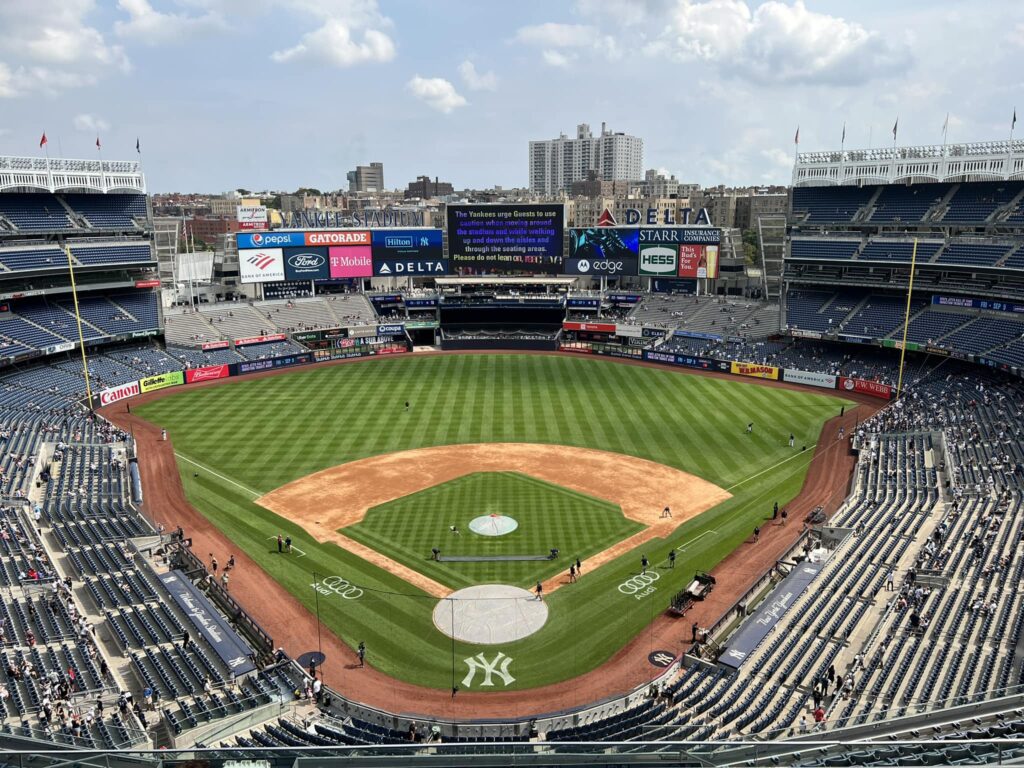
Commonly criticized for its cold, corporate revenue-generating nature, The House That Jeter Built is certainly a fashionable place to hate. Some variation of “I’m a Yankees fan, but Yankee Stadium sucks, and I far prefer Citi Field” is a popular sentiment on social media. “A mall with a baseball stadium in the middle.” “It doesn’t hold a candle to the House That Ruth Built.” I get it.
I don’t think this is a hot take given its #18 ranking, but put me in the camp that thinks this so-call characterless mausoleum gets too much hate. Come on, it’s not that bad!
Conceived as “part Stadium, part Museum,” I think Yankee Stadium does a lot of things that only work because its Yankee Stadium. It fits the vibe of the team.
The exterior is fitted with imposing tones of limestone, granite, and pre-cast stone, stately and handsome for sure, but with an air of self-importance of a new courthouse. Positively palatial. Except for the frieze, the interior aesthetics are mostly non-descript, lacking much character or warmth, but how else would a new Yankee Stadium look? It really wasn’t incumbent on the Yankees to build a park with striking visuals like in Pittsburgh. It was always going to be an enclosed circular bowl reminiscent of Yankee Stadium I in the Bronx.
Inside and out, everything is fitted in muted tones of white, grey, and blue, which would be too sterile and bland in any other park, but it works for me at Yankee Stadium.
Yankee Stadium is generally functional, with plenty of space on the open concourses when you include the Great Hall, decent seating geometry, and the most non-premium padded seats of any MLB park. Demerits for the unacceptably narrow concourse in center field that feels like a concrete tunnel, along with the atrocious gate lines.
The amenities are well above average, but I think some of the offerings are aging as of 2024. While the Yankees did a great job adding new social spaces around the concourses in the late 2010s, a steakhouse (NYY Steak) and a Hard Rock Café in a ballpark feels passé. While the food variety is above average (and Lobel’s is outstanding), the craft beer is now the absolute worst in MLB. For what it’s worth, premium services remain stellar, with the Legends Suite being the single best area for food in MLB, at an exorbinant cost of course.
Yankee Stadium’s strongest features center around team history. Along with tasteful photographs of Yankee greats above the concessions on the main concourse, Yankee Stadium showcases: 1) Monument Park in center field, 2) the Yankees Museum, and 3) the positively monumental Great Hall.
Some say Yankee Stadium itself feels too much like a museum, but as a sucker for ballparks with team historical exhibits, I love it. Yankee Stadium may not reflect New York City, but it certainly reflects the New York Yankees.
While Yankee Stadium doesn’t have the charm or character of the best parks, it has plenty of solid features that emphasize fan comfort and scream Yankees baseball.
17) Citi Field (2009), New York Mets: 82.5
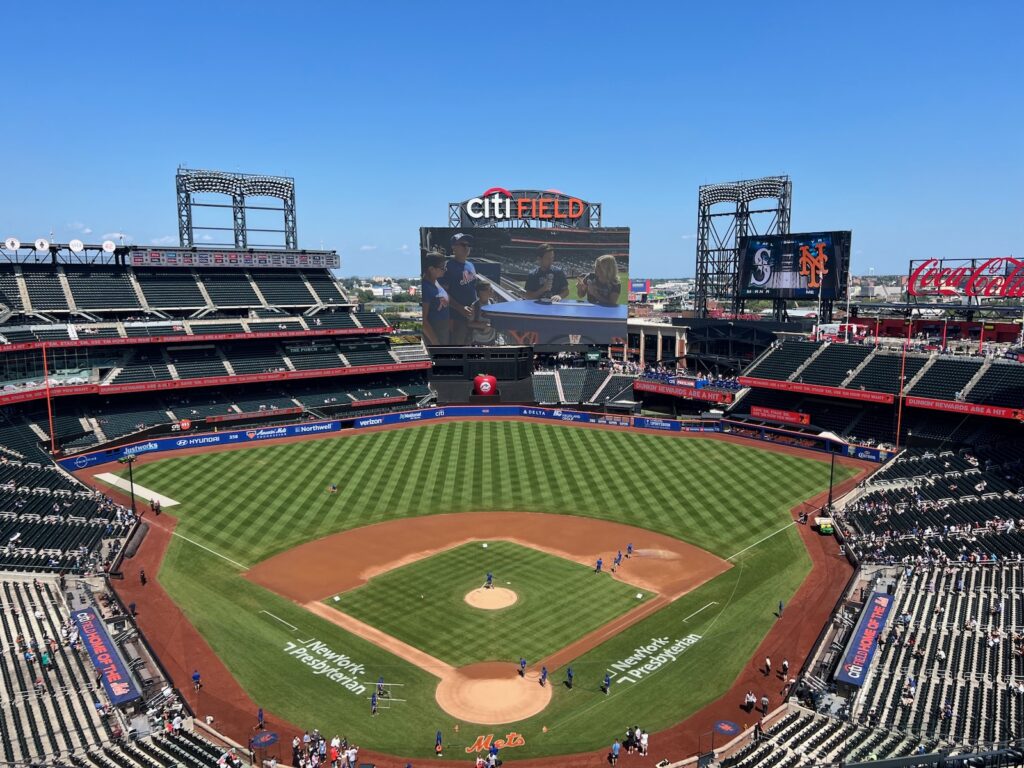
While Citi Field was criticized for its heavy-handed mimicry of Ebbets Field and tone deaf nods to the Brooklyn Dodgers when it opened, it’s generally seen as a park that’s “aged well,” usually landing in the top half of ballpark rankings. It has aged well, but my lukewarm view toward Citi Field stems from two of my core preferences where the Mets’ home falls short:
1) Locations integrated with urban communities. While I love Citi Field’s accessibility off the 7 Train, Willets Point makes for one of baseball’s worst neighborhoods, characterized by ugly repair shops and scrap yards. At least some of that has demolished for the new soccer stadium, but there’s nothing of interest around the park. Parking lots and ash heaps.
2) Open outfields sporting attractive visuals. I get that the Mets are going for the enclosed, “cozy” Ebbets Field-vibe, but if I had a motto for ballparks, it would be “backdrops, not bandboxes.” Citi Field feels too hermetic on the inside. The Shea Bridge also feels forced, to highlight just one gimmick, and the dimensions and interior lines are contrived given the location.
Adorned with classic red brick archways and a grand rotunda, the exterior is gorgeous, but I also just don’t think retro was the right design choice here. Ebbets Field was in part so charming because it was shoehorned into a venerable neighborhood, structurally integrated with a Brooklyn community. Citi Field has this “contrived faux-retro in a parking lot” theme park vibe, almost pretending to be in 1950s Brooklyn, and neoclassical architectural treatment had become decidedly overdone in baseball by 2009. It revels in nostalgia, incongruously out of context in a Queens parking lot. Whereas Yankee Stadium, which also opened in 2009, naturally had to go retro and emulate its first iteration, the Mets had no excuse not to build a forward-looking ballpark.
All of that being said, Citi Field somewhat overcomes this, because the fan experience, while not perfect, is objectively phenomenal.
The inside of the Jackie Robinson Rotunda makes for one of baseball’s most rousing entryways. Citi Field is functional across the board, and the center field plaza is a fun hang out spot. It has baseball’s largest videoboards. It has some of baseball’s very best food, with a bountiful selection of yummy staples from around the city, only behind that in San Diego. The premium club setup is incredibly fan friendly, with a “club access chart” that allows many more fans than usual to access to plush pregame spaces.
And even after significant demerits for relocating the Mets Museum from the rotunda to a small room in center field (hopefully this will be fixed in the future; it’s really unacceptable), Citi Field celebrates Mets’ history fairly well, a sore spot in its early days.
In the end, this isn’t how I would have designed a ballpark for the Mets – and I’ll never get over the lousy setting – but the ballpark operations are firing on all cylinders.
B (+) Tier: The Great Ballparks
A minuscule 4.5 points separate #16 and #7, so don’t get too hung up on the rankings here. While these parks may still have flaws, these are all phenomenal ballpark experiences that should be on any ballpark enthusiast’s shortlist to visit.
16) Nationals Park (2008), Washington Nationals: 84.5
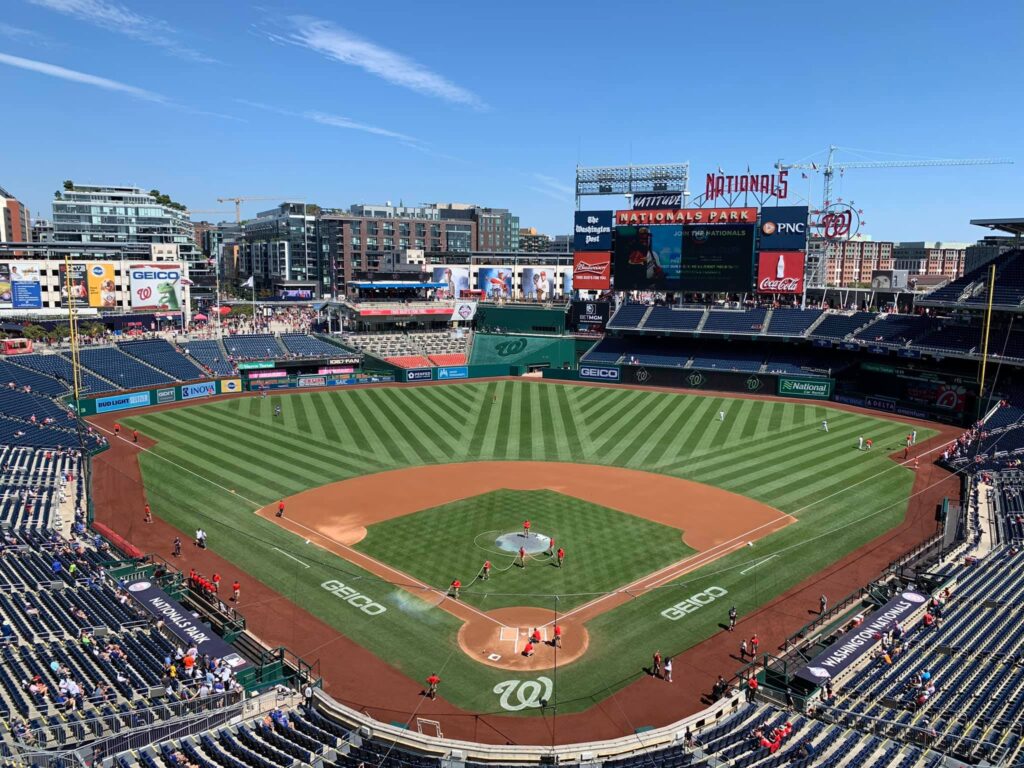
Except maybe Nationals Park, which earns its placement on this list due to its well-roundedness that should please regulars, not any memorable “wow factor” that’s likely to impress ballpark chasers. In the face of high expectations to deliver an iconic ballpark fitting for America’s pastime in the nation’s capital, Nationals Park has received mixed reviews for its lack of distinguishing features, not to mention its lack of visuals that reflect Washington D.C.
Critics say, what’s the first thing you think of when you think of Nationals Park? True, that’s tough! The red seats in center field? The distant view of D.C. landmarks, which are increasingly obstructed by development? The left field cherry blossoms planted as an afterthought that only bloom for a week in early April?
Regardless, I still view Nationals Park more positively. It may lack much to separate it from other MLB venues, but Nationals Park is very well rounded, with few significant flaws, and that matters.
Nationals Park’s architecture may be a mixed bag, but the austere grey treatment fits into the D.C. landscape, which is the goal. Its interior may lack distinctiveness, but I love how open the park feels to the urban context on the left side, with new development and rooftops overlooking the field.
Nationals Park excels functionally, with solid sightlines, good seats, and a new videoboard for 2024. The concourses are particularly well designed: wide, open to the field, and easy to navigate. It’s equipped with plenty of fan-friendly amenities, namely a criminally underrated culinary scene, vibrant social spaces, and amazing premium club seats that have always been relatively affordable on Stubhub. It even possesses a few charming local traditions, namely the now iconic President’s Race and nods to D.C. baseball history.
Most importantly, the burgeoning Navy Yard next door is now one of baseball’s best neighborhoods, and remember, location is crucial in my ballpark ratings. It’s hard to score too low in my rankings if you’re an urbanist ballpark.
Yes, a ballpark is more than the sum of its parts—Nationals Park lacks that “wow factor,” which limits its “repeat value” for out-of-towners—but the sum of its parts is really damn good here, even if nothing is particularly memorable or outstanding.
15) Truist Park (2017), Atlanta Braves: 85

Truist Park has garnered a huge diversity of opinions since its opening. Some see Truist as the bland suburban mallpark epitomized, while others view its mixed-use development and fan-friendly amenities as the model for future MLB ballparks. For me, it’s both.
On one hand, Truist Park is baseball’s ultimate mallpark, where almost everything is all about creating “experiences” and generating revenue, not about crafting attractive aesthetics. Called a “watershed moment” by MLB officials, Truist Park is largely defined by the Battery Atlanta, a privately-controlled pseudo-city in suburbia trying to manufacture the organic sensibility of an urban neighborhood. The traffic and lack of public transportation is a huge drawback.
Even for red brick, Truist’s exterior architecture is generic, lacking any distinctive design cues or regional accents. The interior is so lacking in any describable aesthetic it might as well have been taken from a videogame’s expansion team ballpark starter kit. Inside and out, it looks like the Braves picked Truist Park out of a box that said “baseball stadium.” No visual sense of place. Lame views. Little character. Broadly attractive, sure, but designed to be as inoffensive as possible. A modern-day cookie cutter.
On the other hand, that’s all academic once you’re there, as it’s hard to deny that Truist Park is both functional and incredibly fun. The “fan experience” at Truist Park, separate from any misgivings about the aesthetic design or general artificiality of the ballpark concept, may be the very best in Major League Baseball.
In terms of food, drinks, social spaces, interesting seating options, historical tributes, and entertainment features (zip line!), we are seeing novel concepts entering uncharted territory. There’s something for everyone at Truist Park in every conceivable way, and that’s important for getting casual fans to the game. Monument Garden is undoubtably Truist Park’s standout feature inside, perhaps baseball’s best celebration of team history, and for all my philosophical objections, The Battery is a blast outside.
In the end, the fan-friendly amenities are sufficiently elaborate to offset the pedestrian structure.
14) Progressive Field (1994), Cleveland Guardians: 85.5

While the artist formerly known as Jacobs Field received rave reviews in the 1990s, it doesn’t get a lot of love from baseball writers and ballpark enthusiasts today, making it one of the more underrated ballparks in my book.
Opening on the heels of Camden Yards, Progressive Field’s architects understood that the Camden philosophy was about constructing something contextual that connected to the city, not red bricks or silly old-fashioned gimmicks. Progressive Field nails that, in what is a symbolic representation of Cleveland.
The exterior architecture utilizes limestone and white steel evoking Cleveland’s industrial sensibility. Progressive Field’s authentic urban interior aesthetics are lovely, eschewing any semblance of gimmickry and adroitly responding to the contextual forces of the city. Those toothbrush light towers represent the town’s smokestacks.
Much needed enhancements in the 2010s greatly improved the fan experience. Dividing the main concourse into “districts,” Cleveland’s park now has a) one of baseball’s largest videoboards, b) some of baseball’s best local food and craft beer, c) the outstanding right field Corner Bar, d) new clubs and renovated lounges, and e) one of baseball’s largest children’s areas, among other things. Heritage Park in center field also celebrates team history well.
Progressive Field doesn’t have many flaws, but its few flaws are pretty significant. Seating geometry down the lines is poor, three tiers of luxury suites isolate the upper deck, and the mezzanine is for all-inclusive premium club seats only. The combination of these three factors means there aren’t many good seats for the average fan! The old seats are also some of the very worst in terms of condition.
But overall, underrated aesthetics and some of baseball’s best amenities already mean Progressive Field scores well in my book.
Moreover, Progressive Field is currently undergoing another multi-year, $202.5 million renovation project. In 2024, new bars and social spaces were added, with some replacing the hideous shipping containers in right field. Right now, it’s a work in progress – there are plenty of unfinished parts and having the seats half green/half blue looks weird – but 2025 will bring more social spaces and a new home plate club, and by 2026 all of the new blue seats will be installed.
I expect Progressive Field to be on the periphery of the top-10 once the renovations are completed, depending on the execution.
13) T-Mobile Park, Seattle Mariners: 86
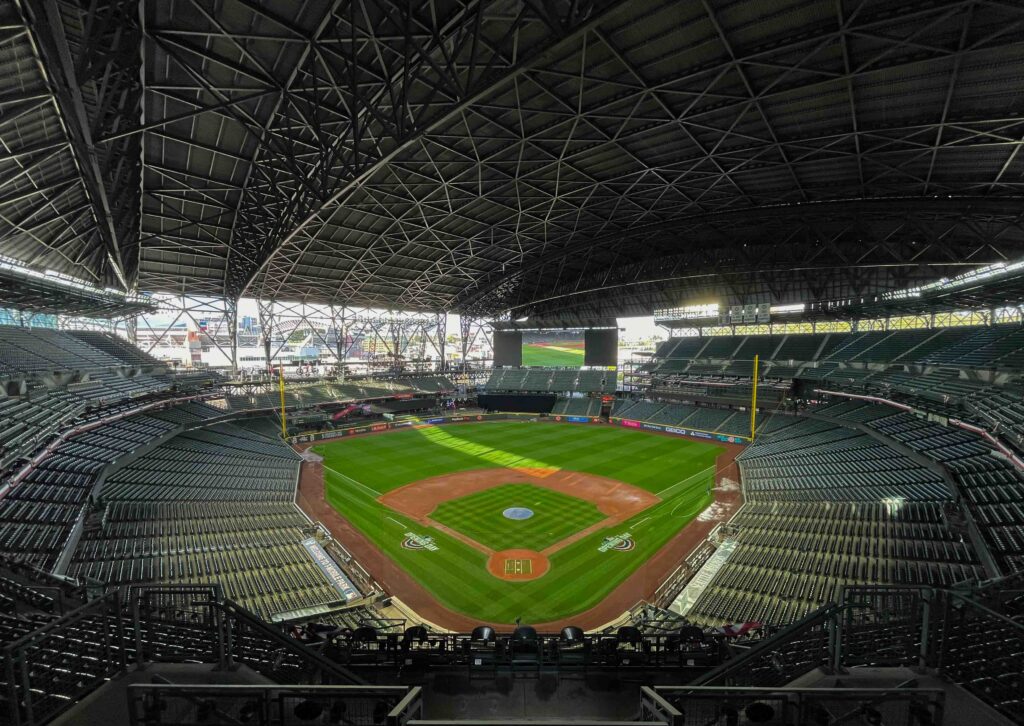

Heralded for saving baseball in Seattle, T-Mobile Park has historically been considered one of the best parks in baseball, receiving rave reviews upon opening for its “umbrella”-style retractable roof that doesn’t fully enclose the park and unparalleled array of modern amenities. With a $500+ million price tag, an exorbitant amount for the late 1990s, almost no expense was spared.
Controversially, I’ve always been critical of the stadium’s architectural design. The exterior is utterly disjointed, with the third base side wrapped in red brick and the first base side exposed in unadorned steel.
While some parts of the upper deck sport phenomenal views, most of T-Mobile’s interior visuals lack a defining focal point other than that bulbous roof, with poor attention to the urban context and haphazardly placed outfield grandstands. No visual sense of place from the lower bowl.
However, there’s no denying the fan-friendliness of the Mariners’ home. The gameday experience has aged well despite relatively few enhancements over the years, because T-Mobile was way ahead of its time in offering those extra frills. It’s also supremely functional in all facets.
The food and craft beer are among the very best in baseball, only behind San Diego taken together. The Pen in left field is baseball’s prototypical social space, which includes baseball’s best views into, you guessed it, the bullpens. The main concourse is open to the field without interruption, and the concourses have so many cool SRO areas. The videoboard is one of baseball’s largest. New social spaces like Edgar’s Cantina, the Rooftop Boardwalk, and the Trident Deck are well done. The newly renovated premium Diamond Club behind home plate, based on my experience, may be the best of its kind in baseball. The Mariners Hall of Fame and Museum is a must-see attraction. And the “Art in the Park,” headlined by the chandelier of 1,000 translucent bates in the rotunda, remains the showstopper.
In sum, I think T-Mobile Park’s structure and aesthetics are a tad overrated, but the rest of the fan experience is top notch.
12) Citizens Bank Park, Philadelphia Phillies: 86.5

For something as subjective as ballpark rankings, with all their variations based on roots and loyalties, there’s a rare consensus here: fantastic park, less-than-ideal setting.
Philly fans will tout the logistical efficiencies, but Citizens Bank Park is almost defined by its South Philadelphia Sports Complex location, because any shortcomings are a function of that location. Drag the park 4 miles north and witness the closer skyline views, much-needed sense of place, and vibrant local scene, and you would have a top-5 park.
Location and views are huge in my book, but CBP does almost everything else right. Leaving the classic Dodger Stadium out of the equation which is a different animal, this is my highest ranked “parking lot stadium.”
Aesthetically, the interior sports clean lines, an engaging color scheme, a unique angular grandstand design, and one of baseball’s most beautiful batter’s eyes. This is about as visually attractive as a parking lot stadium gets on the inside. Functionally, CBP’s sightlines are excellent, and the concourse design may be baseball’s very best. The concourses open to the field on all three levels, with no interruptions in visibility throughout the main concourse, numerous fan-friendly SRO areas, sitting areas feet from the bullpen, and Ashburn Alley in the outfield. It now has one of baseball’s largest videoboards as well.
Elevated by recent renovations, CBP’s amenities are impressive. Local culinary staples like Tony Luke’s, Campo’s, and Federal Donuts remain scrumptious. Recent enhancements added (a) a wonderful sports bar with an open-air beer garden, (b) a redesigned historical exhibit in left field, and (c) one of baseball’s premier kids’ areas, among other things. Then throw in the passionate Philly fans, and you’re looking at a memorable experience.
Other than lacking that all-so-important sense of place provided by a downtown location, Citizens Bank Park is one of the most fan-friendly parks in baseball.
11) Busch Stadium, St. Louis Cardinals: 87
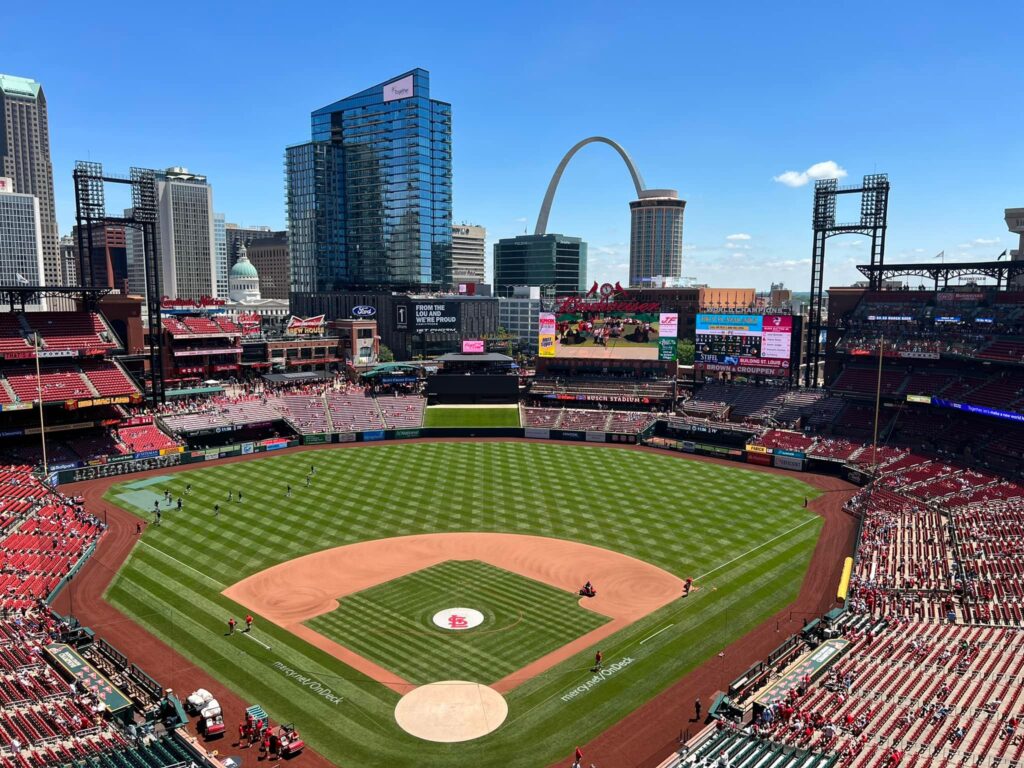
Busch Stadium is one of the more difficult ballparks to assess, because nearly all of its assets are derived from factors independent of the actual building that was heavily value engineered. I see Busch Stadium as kind of the opposite of Citizens Bank Park, as with the latter, all of its strongpoints are derived from features within the confines. In St. Louis, the park is great due to external factors.
Baseball’s 2nd best skyline views showcasing the Gateway Arch, a now-completed Ballpark Village in Downtown St. Louis, and the Cardinals fanbase bolster the overall Busch Stadium experience, but there aren’t many frills to elevate a fairly prosaic structure.
1) Independent of the postcard views, Busch Stadium is one of the most generic parks of its era, perhaps epitomizing the peak “retro cookie cutter.” While other parks with skyline backdrops seem more organically interwoven with their urban context, Busch Stadium feels kind of dropped from the sky into Downtown St. Louis, with a boring outfield seating design that could be mistaken for a cookie-cutter facility. The interior feels like a template, a generic starting point without any distinction in its own right.
Recalling local architecture, the exterior facade is admittedly beautiful (and the signature entrance pays superb homage to the Eads Bridge), but it comes across as a bit too formulaic and derivative for 2006, and I don’t think neoclassical red brick was the right design choice for the city.
2) Independent of Ballpark Village outside of the park, the amenities inside of the park are unimpressive, with a main concourse closed to the field (highly unusual for a 21st century park), poor to pedestrian food and craft beer quality, and a notable lack of destination social spaces within the footprint, although the new right field terrace is nice. The Cardinals Hall of Fame in Ballpark Village is outstanding, but there’s aren’t many historical tributes that scream Cardinals baseball within Busch’s confines.
The view, the fans, and the features outside in Ballpark Village alone are outstanding enough to get Busch Stadium on the periphery of the top-10, which says a lot about how good they are (hey, how low can I rank a park with baseball’s 2nd best skyline views?), but I take a mixed tone here, because this place should have been even better.
10) Dodger Stadium, Los Angeles Dodgers: 87.5
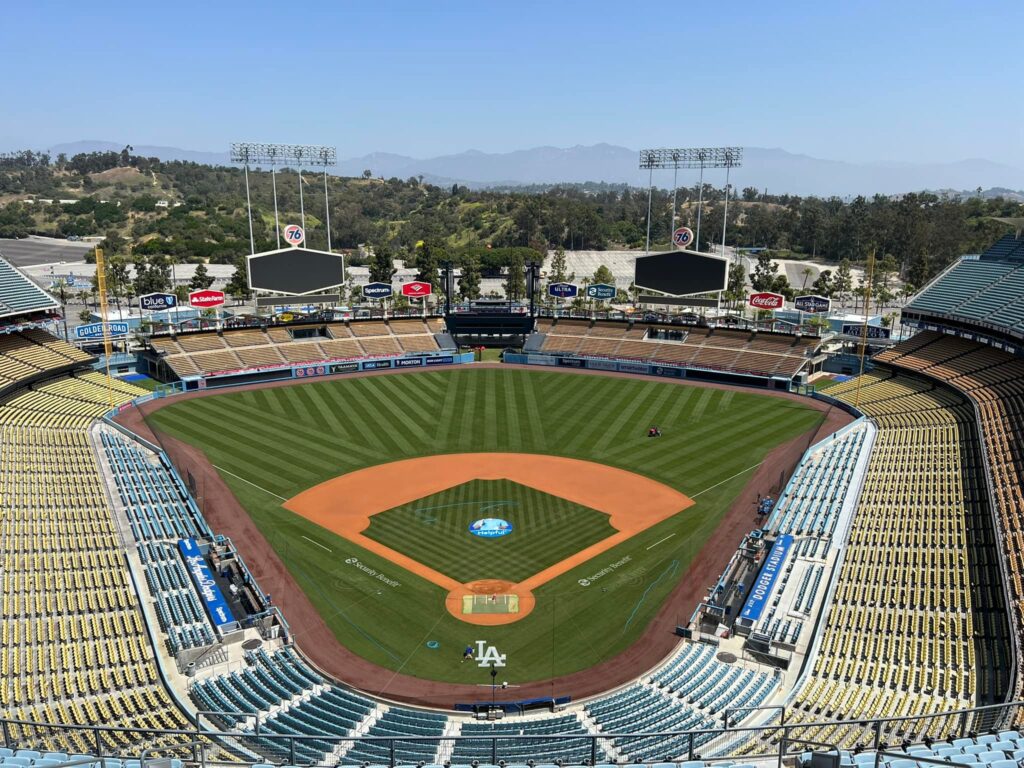
Dodger Stadium is baseball’s most polarizing park. I’ve seen Chavez Ravine placed in the top 5 or top 10 for its Mid-Century Modern aesthetic, but just as frequently put in the middle of the pack or even bottom half, with folks citing what a total nightmare it is to get to.
Yes, Dodger Stadium’s crippling traffic, exacerbated by the park’s lack of walkability and nonexistent rail access, may the worst part of a day at any MLB park. A flaw that simply cannot be overstated, and the urbanist in me struggles to rank Dodger Stadium this high. But once you get there, Dodger Stadium earns high marks across the board, especially after the 2020 renovations.
Carved into the hillside of Chavez Ravine and without much of a traditional “façade,” the exterior is Mid-Century Modern architecture at its finest. Inside, Dodger Stadium exudes a simple splendor, defined by the green-lined hills and San Gabriel Mountains beyond the outfield and the iconic pastel color scheme of the seating bowl reflecting Southern California’s natural landscape. No gimmicks. Just understated, authentic beauty in keeping with its context.
Just in terms of pure, serious “capital-A” architecture, I could make the argument there’s still no better ballpark in baseball inside and out.
Functionally, the sightlines are good, and the renovations made Dodger Stadium a 360-degree experience. The exterior grounds are spotless. The open concourses and seating bowl are immaculate. The retro 1960s-style signage is one of a kind.
The new outfield Plaza is fabulous, adorned with destination restaurants with views into the bullpens, proper sit-down bars, communal gathering spaces beneath suspended decorative beach balls, appropriately subtle kids play areas, a batter’s eye with pregame field views, and most importantly, well-designed field game viewing platforms. Team historical tributes/exhibits are wonderfully interwoven throughout the concourses on all levels of the park, including bobblehead displays, Legends of Dodger Baseball plaques, a Fernandomania celebration, rotating Negro League exhibits, a museum on the suite level accessible to all fans, and tons of decorative keepsakes like old signage, seats, a ticket stubs. Overall, Dodger Stadium has decent amenities after the renovations and certainly punches above its weight in this category for a 60+ year-old stadium.
Sure, Dodger Stadium isn’t perfect even putting aside the traffic – the concession food/beer variety and quality still needs improvement and the concourses are a tad narrow – but its iconic architecture, timeless aesthetics, superb sightlines, lasting functionality, unforgettable character, and now state-of-the-art amenities stand up against any park.
9) Coors Field, Colorado Rockies: 88

Now amazingly the 3rd oldest ballpark in the National League behind classics Wrigley and Dodger, Coors Field has aged remarkably well. Opening on the heels of the revolutionary Camden Yards (1992) and the well-received Progressive Field (1994), Coors Field created the template for the modern-day neotraditional ballpark in 1995.
With its open concourses and great sightlines, Coors Field fixed many of the functional flaws seen in those two predecessors, while perfecting the Camden philosophy of crafting a contextually-inspired ballpark free from contrivances or gimmicks.
Coors Field’s famous mountain views may be overrated—the sweeping vistas are gorgeous, but they are only visible from some upper sections and are only spectacular at ideal times; the park’s interior visuals are underwhelming overall—but Denver’s park does almost everything else right.
LoDo makes for one of baseball’s very best neighborhoods. Coors Field features my favorite ballpark exterior design, taking retro red brick to “capital-A” architecture territory and fitting in with LoDo like a glove. There’s the rockpile geyser in center field and the purple seats in the upper deck marking one mile above sea level. Coors Field holds up well from a functional standpoint. The in-park brewery is fun, even if the park’s food has fallen behind the times. And 2010s enhancements added the outstanding Rooftop party deck filled with fan-friendly social spaces and the videoboard shaped like a mountain.
Overall, Coors Field is very well-rounded, checking most of the boxes, while possessing a few exceptional features and timeless architecture. You may not instinctively think of Coors Field when pondering which ballparks are likely to withstand the test of time into the mid-21st century, but Denver’s ballpark has the core ingredients to do so.
8) Oriole Park at Camden Yards, Baltimore Orioles: 88.5

Camden Yards, aptly said to be of equal significance in baseball history to the breaking of the color barrier and the development of free agency, inspired decades of “old-fashioned ballparks with modern amenities.” The venerable sensibilities associated with generations of neotraditional “retro” ballparks—the asymmetrical dimensions, warm brick facades with exposed steel, green seats, and various historical nods—were born here.
However, the importance of Oriole Park transcends conversations about its superficial stylistic treatment. Not only did it pioneer many subtle design elements that are commonplace today, but it ushered in a broader trend of American urban rival, reinvigorating the country’s downtown cores.
Camden Yards’ brilliance lies not with its old-fashioned design, but with its philosophy that ballparks can be made better by abandoning templates and constructing something contextual. Camden’s neoclassical architectural treatment was authentically inspired by its urban surroundings, not conceived of in a vacuum like some of its retro cookie cutter successors, and therein lies its ingenuity. The building is in perfect harmony with Baltimore.
Despite receiving few significant enhancements in its 30-year history, Camden Yards still holds up well today inside and out. Surrounding views may happen to be better at parks in Pittsburgh and San Francisco, but one could argue Camden’s interior aesthetics have never been eclipsed.
With the B&O Warehouse serving as a landmark on par with Wrigley’s ivy or Boston’s Green Monster, Camden’s interior design is simple, coherent, authentic, and attractive, lacking the busy distractions of the newer ballparks, while also having that organic, uncontrived “signature feature.” The authenticity of the warehouse remains unmatched.
A charmingly simple red brick façade, skyline views, local grub (Boog’s BBQ and Jimmy’s Famous Seafood!), Legends Park statues, Eutaw Street, and brass baseball designating every home run to land on Eutaw Street also define the park.
Significance doesn’t equal perfection, and Camden falls short of the newer parks in a number of respects, hence its placement at #8. Just in terms of essentials, the concourses are almost entirely closed from the field, the seating geometry down the lines can be terrible, upper deck seats lack cupholders, and the videoboard is the smallest and among the most outdated in MLB. Cumulatively, the amenities are below average as well.
$600 million has been earmarked for renovations to Camden Yards, which I expect will catapult it to the top-5.
7) Comerica Park, Detroit Tigers: 89
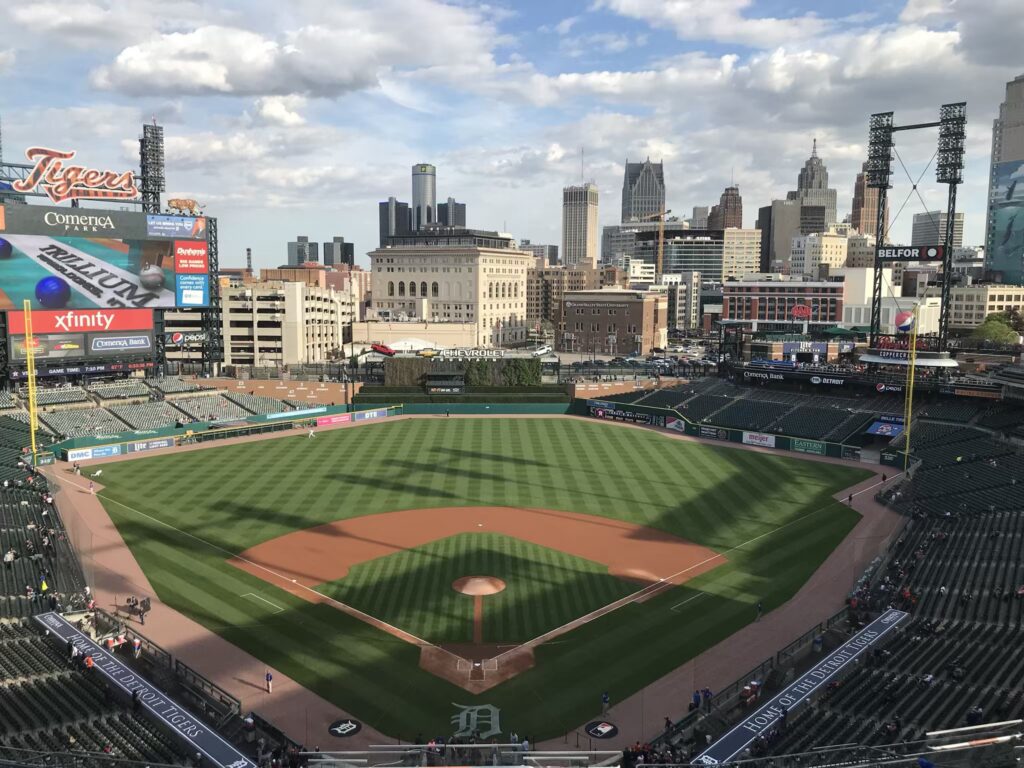
I did not create this site to generate indefensible hot takes. Until now, not much on this list significantly diverges from conventional wisdom. However, my take on Detroit’s ballpark is the site’s most controversial, one of the few times where I sharply deviate from the consensus. In fact, Comerica ranks #7 after a downgrade, as this place admittedly needs some TLC, which has started in 2024 and will continue into 2025.
Suffering by comparison to the venerated Tiger Stadium, Comerica Park generally hasn’t received the praise of other 21st century ballparks. Comerica is also hindered by its association with the blight of Downtown Detroit and sightline complaints, both of which are misunderstood or overblown. Most ballpark aficionados rank Comerica in the mid to lower-mid tier (#14-#22 range).
Assessing Comerica on its own merits in the context of its post-1990 peers and not to the all-time great Tiger Stadium, I think it’s by far the most underrated ballpark in MLB. It could shoot up to top-5 status again with much needed renovations. Consider:
- A downtown locale with surrounding bars and restaurants? Check.
- Wonderful exterior architecture, defined by marvelously expansive exterior monuments in the form of Tiger sculptures creating an immediate and memorable sense of arrival? Check.
- Understated interior aesthetics with the best ballpark skyline views outside of Pittsburgh and St. Louis, along with one of baseball’s most beautiful batter’s eyes topped with a fountain? Check and check.
- The lowest upper deck of the newer parks outside of Pittsburgh, making for underrated sightlines? Check.
- A variety of new local food options for 2024 headlined by Marrow and rotating regional staples, formerly a sore spot for Comerica for a quarter century, along with tremendous Michigan craft beers? Check and check.
- New for 2024, baseball’s second largest videoboard? Check. (Of course, Tiger fans somehow found a way to complain about this too).
- Wide, open concourses with tremendous SRO areas, loaded with a panoply of destination restaurants, taprooms, beer halls, and social spaces accessible to all fans? Check and Check.
- Historical memorabilia and statues of Tiger legends adeptly interwoven throughout the concourses, but with frivolous kids-friendly attractions like the Ferris Wheel and Carousel relegated to the outskirts? Check and Check.
1) Above-average downtown locale, 2) Gorgeous aesthetics inside and out, 3) Supremely functional, and 4) Filled with fan-friendly amenities for fans of all ages. Very well rounded.
Of course, a ballpark is more than the sum of its parts, and the through line creating that necessary “wow factor” is just how elaborately Comerica represents its tenant.
Tiger sculptures, gargoyles, and claw marks outside. View of the Detroit Athletic Club, Downtown Detroit, and the red brick Wall of Fame inside. A team “walking museum” in the form of “decade bats” and statues of Tiger legends throughout the concourses. Tigers embroidered on the doors; Tiger sculptures above the bars. Close your eyes, step almost anywhere in or outside the ballpark, open them, and you’ll see something that screams “Detroit!” or “Detroit Tigers!”
There is a strong sense of place here, as everything shrewdly incorporates elements of the city and the franchise.
Comerica Park is not flawless, of course. I concede some of the above is aging. Despite the improvements, the concession stand food could still be better. The incline of the lower bowl is too gentle, but that’s a common problem of ballparks of this era (even if it’s a tad worst here), making it odd to see Comerica always singled out. The outfield seating and fences need to be redone again, as the new fences moved in twice have a makeshift look. Some of the interior lounge spaces badly need a renovation in particular. And day games are no fun in certain spots with the blinding sun, a function of Comerica’s south-ish orientation.
But overall, it seems like fans who are inclined to opine on their Comerica Park experiences downplay its many assets and seriously exaggerate its few shortcomings. Local fans and media drive the narrative about a ballpark, and I believe Tiger fans and the Detroit media created a lasting national perception that Comerica Park is so-so, at best. In my view, that’s largely because it replaced Tiger Stadium. Even acknowledging Comerica’s few shortcomings, I can’t find an alternative explanation.
If Comerica Park replaced a Three Rivers Stadium like PNC Park did in Pittsburgh, this ranking wouldn’t be controversial.
A Tier: The Two Classics
For years, I declined to rank and rate the two classics, Fenway Park and Wrigley Field. There is simply no way to properly quantify the unparalleled sense of history and authenticity of these grand cathedrals, so such comparisons to the other 28 parks are grossly unfair. It’s like comparing the Roman Colosseum to baseball’s array of Sydney Opera Houses. Fenway and Wrigley must be solely looked at in their historical context.
But that’s just no fun, right?
Some say Fenway and Wrigley are objectively dumps, should be retired into the museum of great old ballparks, and should ultimately rank toward the bottom. That certainly doesn’t ring true, especially since both have undergone hundreds of millions in renovations in the 21st century.
Others say as the venerated historical cathedrals of America’s national export, any ranking that doesn’t put Wrigley and Fenway #1 and #2 in some order is illegitimate. That doesn’t strike me as right either given the quality of some 21st century ballparks.
Here’s where I land on Wrigley and Fenway, conceding that opinions on these ballparks are highly subjective.
6) Fenway Park (1912), Boston Red Sox: 89.5
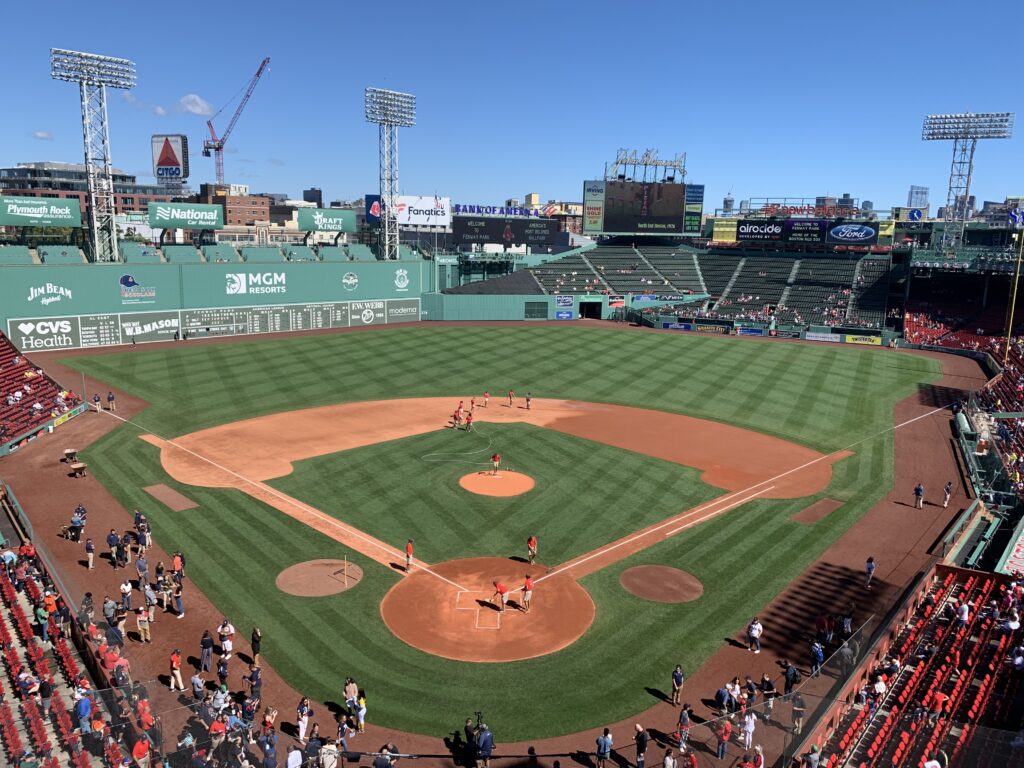
Fenway Park is in a class of its own as a bonafide historical destination. With all of its charming quirks, timeless traditions, and historical baseball moments, the moniker “America’s Most Beloved Ballpark” fits the bill. No park is more pure baseball than Fenway Park.
Fenway-Kenmore is still one of the best neighborhoods in baseball, with rows of sports bars surrounding the park. Outside, Fenway Park’s approach never ceases to amaze me, as it looks like a neighborhood building. Fenway’s iconic red brick facade looks like it hasn’t been touched since the years of the Model T. Simply inimitable.
Inside, how many ballparks have so many interior elements with proper names? The Green Monster and The Triangle. Pesky’s Pole and The Long Red Seat. The venerable shades of red and swamp-like green that define Fenway’s color scheme evoke a certain timelessness of classic baseball. The interior as a whole is authentic, attractive, and distinctive. Simply inimitable.
During the renovations in the early 2000s, Jersey Street (Yawkee Way) was incorporated into the ballpark, a wonderful pre-game space to congregate. The quality and selection of Fenway’s grub is much better than an out-of-towner might think, headlined by Luke’s Lobster. Fenway is surprisingly family-friendly, with games on the Kids Concourse in right field. Even the premium seating is remarkably well integrated into the preexisting architecture.
The single most impressive thing about Fenway Park that you don’t see on TV or Instagram is the phenominal memorabilia throughout the concourses, including old ticket booths housing championship keepsakes and plaques noting significant parts of Fenway. A living museum, for sure.
Fenway Park falls short, notably compared to Wrigley Field, in functionality. Not only are Fenway’s seats and aisles comically narrow, but the bowl is rife with poorly angled seats and overhang/support column obstructions. In particular, the seating geometry down the right field line is horrific, with 1000s of seats oriented past center field. The main concourse is understandably narrow and confusing to navigate.
While it’s tricky to rank given that fact, Fenway Park compensates everywhere else. With incomparable intimacy and charm, it takes the crown as baseball’s most memorable ballpark, as it’s the only one with a “hangover effect” for me, where I’m always left in awe of the experience for the next week.
5) Wrigley Field (1914), Chicago Cubs: 90
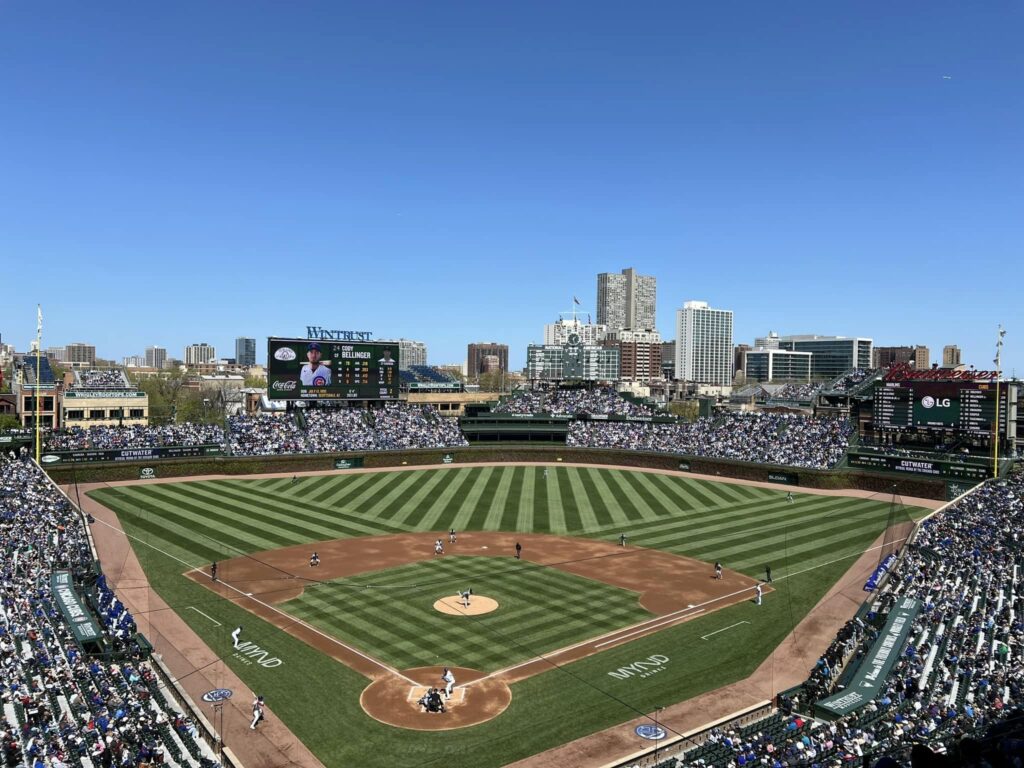
A common refrain in the past was that even with all of the beauty and history, Wrigley Field was “a dump.” Given that the multi-year $575 million renovation project has been completed, Wrigley Field now has a fan experience on par with the aesthetics and history. Just objectively speaking, this sure isn’t a dump anymore.
Considered one of the best neighborhoods in professional sports, Wrigleyville not only has a vibrant pre-and-post-game bar scene, but also evokes a classic residential vibe, reminiscent of the urban neighborhoods of the early-mid 20th century, recent gentrification aside. The park is in perfect symbiosis with the area.
Wrigley Field’s exterior design is simple but gorgeous. The now famous art deco style marquee was installed in 1934. Renovations adding terracotta roofing awnings have enhanced the scene considerably.
Inside, Wrigley Field is godfather of the neotraditional ballpark emphasis on skyline views and integrated community aesthetics. It was the only park from the 1910s era to continue to emphasize a connection to the local community throughout the mid-20th century, because no second deck was added in the outfield. Even in the lower level, we see the neighborhood seep in through rooftop bleachers and distant skyscrapers. The ivy planted on the outfield walls remains my favorite interior aesthetic feature in baseball. The outfield bleachers remain some of baseball’s most enjoyable seats. The manual scoreboard remains iconic.
The renovations extended the bleachers upward and added new videoboards blocking out some of the rooftops, which somewhat dilutes the interior connection to the neighborhood. It doesn’t ruin the ballpark, but the old interior visuals were better.
I also feel like Wrigley’s amenity enhancements were too focused on premium clubs, however plush, compared to the Fenway renovations. The concession food and beverage game, to take one example, is still weak, and it drives me crazy how all fans can’t access the best grub (Small Cheval!) in the bleachers. Cubs’ history is fairly well represented with plaques, the trophy room, and statues, although I would prefer to see more team memorabilia exhibits like at other parks (and Fenway) for a franchise of this age. Gallagher Way, integrated into the park on the third base side a la Fenway’s Jersey Street, is a strongpoint of the renovations.
Wrigley Field holds the edge over Fenway in my book, because it’s remarkably functional for its age. Namely, it’s a good place to actually watch a game! The seats are more comfortable. The decking structure is superior, mostly avoiding overhang issues in the lower deck compared to Fenway while also placing the upper deck closer to the field than every other MLB park. Plus, the seating geometry is fine, unlike other parks of its era.
A Tier: The Outstanding Ballparks
These, including the S Tier, are the four 21st century parks that truly constitute “bucket list” venues. They are either transcendentally outstanding in one or multiple respects with few flaws, or in the case of #4, consistently great in all respects with essentially no flaws.
4) Target Field (2010), Minnesota Twins: 91

Target Field is generally considered a top-10 ballpark. I actually think it’s better than that, comparable to the very best parks in baseball by virtue of its nimble urbanist architecture and across-the-board excellence.
While a handful of downtown ballparks may have more captivating backdrops, Target Field has the most creative and impressive urban design in ballpark history, with plazas, concourses, and outfield seating bowls constructed above streets in right field to expand the footprint, which was originally just 8.5 acres.
Given its adaptiveness to its urban surroundings, Target Field represents a return to the best “retro” ballpark principle of adhering to contextual design, while ironically being one of the least retro parks. With a clean outfield aesthetic free from gimmicks and an abundance of modern limestone inside and out, Target Field screams authentic Minnesota baseball.
Target Field also benefits (1) from being extremely well rounded, as it excels in almost all respects, and (2) from the fact that the Twins have displayed an admirable dedication to continually upgrading the facility despite its young age. As of 2024, it still looks brand new.
While a few other ballparks may be more outstanding in some respects, Target Field does it all:
(a) downtown locale with vibrant local scene
(b) regionally-inspired limestone architecture (even the dugouts have limestone!)
(c) contextually-based interior design
(d) adroitly-integrated downtown views
(e) wide, open, easily navigable concourses on all three levels, above-average sightlines, and a new videoboard
(f) choice local food with great quality (Murray’s, Red Cow, Pizza Luce, etc.) and solid variety (Italian, Indian, Hmong cuisine, etc.), along with tremendous craft beer
(g) a truly fabulous array of social spaces, bars, and restaurants (eight total!) accessible to all fans on all three levels, most of which are climate controlled, only behind San Diego’s Petco in this category with so many places to hang out before the game
(h) generally phenomenal amenities otherwise, including one of baseball’s best mezzanine club levels. I would like more historical tributes inside the park that all fans can see, but this was the single most difficult park to choose a biggest dislike.
At the end of the day, the Twins pad both checks all of the boxes and brings an unmistakable sense of place via unique aesthetic flourishes and locally-inspired amenities.
3) Oracle Park (2000), San Francisco Giants: 92.5
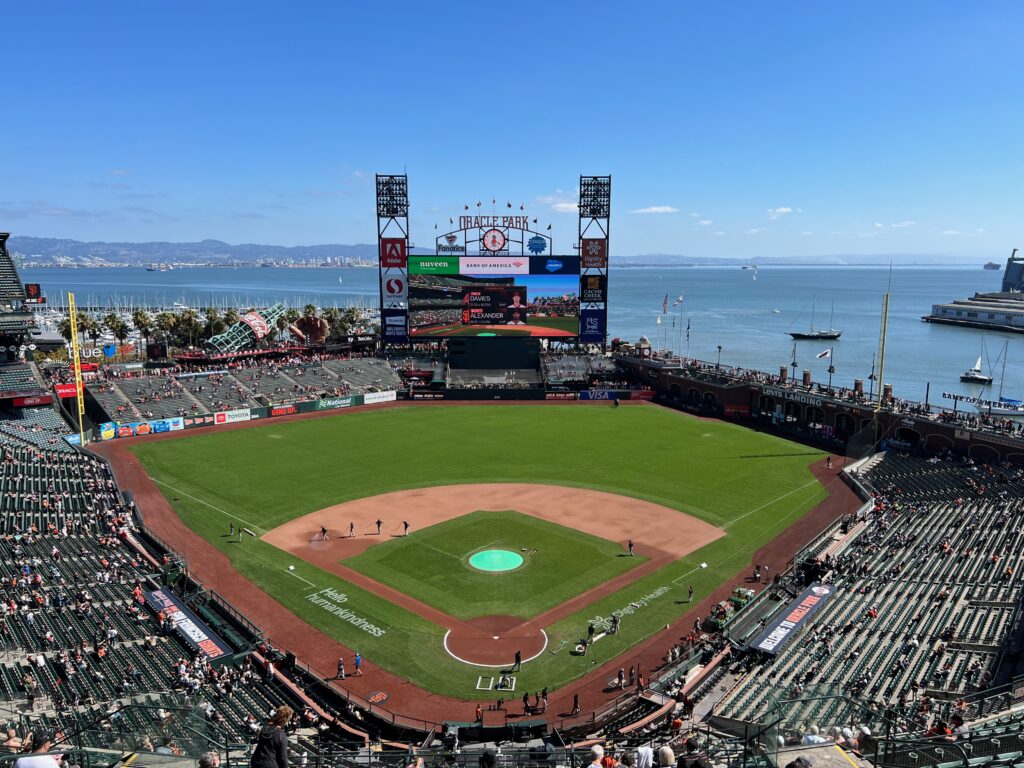
Largely by virtue of its bayside location, splashdown home runs, and postcard views, Oracle Park is widely considered one of the best ballparks of the post-1990 building boom, often compared to its similarly acclaimed contemporary in Pittsburgh.
Like the early 20th century jewel box parks, Oracle Park’s quirky dimensions aren’t contrived. They are dictated by the constraints of McCovey Cove. Running parallel to McCovey Cove, gorgeous archways are integrated within the right field wall. Among an unvaried scene of bleachers in left field, the vintage 1927 four-fingered baseball mitt made of steel and fiberglass looks classy. The 80-foot coke bottle is nostalgic and attractive.
All of this fronts the San Francisco Bay and McCovey Cove, making for arguably baseball’s best backdrop. You also get glimpses of the Bay Bridge and Berkeley Hills. But Oracle Park is more than a ballpark with water views.
It’s fantastic park even not considering the view, which is fortunate because unlike in Pittsburgh, the water and city landmarks aren’t visible from the lower bowl seating. Oracle Park’s amenities are just as good as its famous aesthetics and location.
Consider all that makes the Giants’ park outstanding independent of its locale: (a) some of baseball’s most delectable food and craft beer, (b) unique social spaces like The Garden, (c) one-of-a-kind premium spaces like the Gotham Club, (d) family-friendly features like the Fan Lot, and (e) one of baseball’s largest videoboards. It’s also a strong urbanist park, with excellent public transportation, a vibrant pre-and-post game bar and restaurant scene, and exterior architecture in keeping with the surrounding neighborhood’s red brick buildings.
Just as importantly, San Francisco’s privately financed palace could be construed as the most successful ballpark of the era, generating the most enduring attendance boost of any new ballpark in modern history.
Stemming from its tight footprint, a handful of fairly serious logistical shortcomings prevent me from ever ranking Oracle #1, namely the unacceptably narrow concourses and quirky seating geometry affecting 5,000+ seats down the left field line.
But Oracle Park will continue to be one of America’s most magnificent ballparks for years to come.
2) PNC Park (2001), Pittsburgh Pirates: 93.5

Widely lauded for its views of Downtown Pittsburgh and the Roberto Clemente Bridge crossing the Allegheny River, PNC Park is universally considered one of the best ballparks in baseball. Like Oracle Park in San Francisco and Camden Yards in Baltimore, it has entered broader popular culture as a tourist destination.
Indeed, I’ve grown to see PNC Park as the most beautiful ballpark in baseball inside and out, and it isn’t particularly close. Instead of views of just water, a bridge, or a skyline, you get all three. Instead of views only from the upper levels, PNC’s landmarks seem omnipresent throughout the lower bowl through superior contextual integration and minimized outfield seating.
Moving outside, PNC utilizes a refreshing assemblage of limestone and blue steel in keeping with the riverfront context, not the played out red brick. Rugged materials from the area, including Kasota stone and ochre limestone, form the façade. And the concourses match too. And that approach from the Roberto Clemente Bridge. It’s all just perfect.
Beauty aside, PNC’s intimacy also sets it apart. In an era of ballparks with sprawling towers of luxury suites and 3+ levels, PNC famously utilizes a “double deck” design that just feels cozier. The period when PNC open was characterized by ballparks that just felt too “overdone” with contrivances and gimmicks. PNC is all about baseball and the view.
PNC Park is pretty functional, with great sightlines, a new videoboard, and an open main concourse. The amenities, formerly something of a mixed bag before renovations in 2022 and 2023, mostly get high marks. The tremendous series of sit-down bars and social spaces are a highlight, along with the new Pirates’ historical artwork/plaques, kid-friendly areas, Primanti Bros cheesesteaks, and baseball’s coolest mezzanine club level. The remodeled riverfront concourse is a blast.
PNC Park isn’t quite perfect – a poor food selection, a strange lack of cupholders in the upper deck, vertical discontinuities on the main concourse, and the lack of team memorabilia outside of the premium areas (let’s build a Pirates Museum!) come to mind – but there are no major flaws here.
Coupling MLB’s only modern-day structure built on a human scale with views so unbelievably perfect they wouldn’t be plausible as background in a film set, PNC is transcendent.
S Tier: The Best Ballpark in Baseball
My favorite park in baseball by a comfortable margin.
1) Petco Park (2004),San Diego Padres: 97
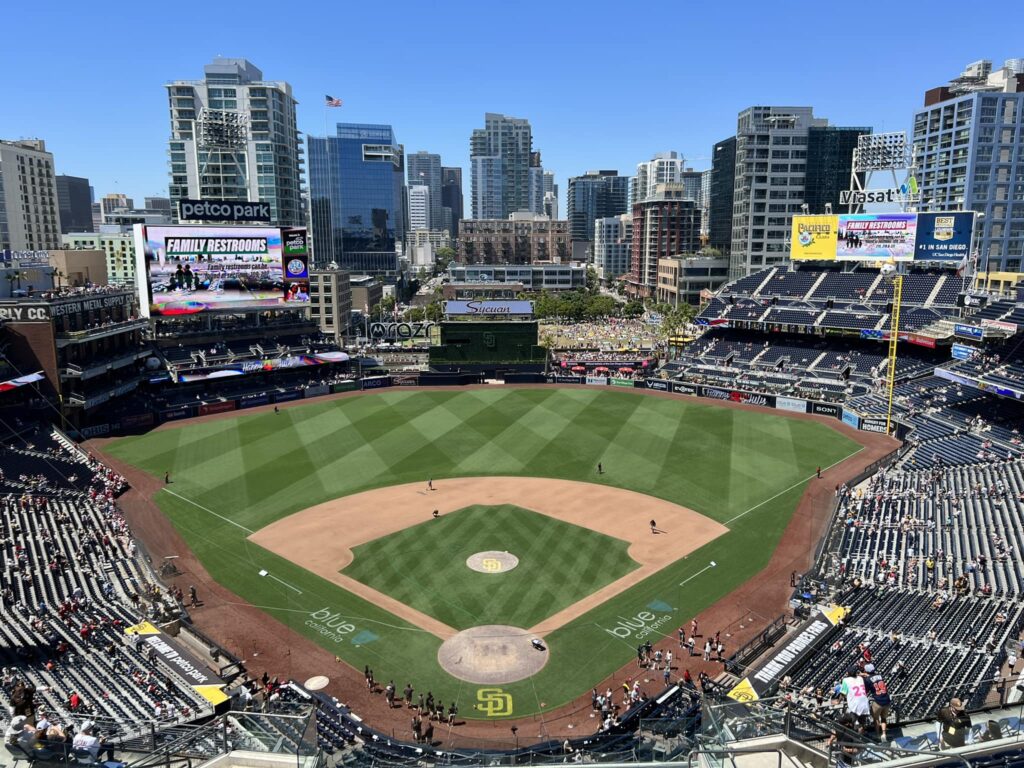
While always defined by outstanding concepts, Petco Park looked unfinished when it opened in 2004. Through a series of enhancements from the mid 2010s to today, San Diego’s pad has put itself right alongside PNC and Oracle in the national conversation for baseball’s best park. As you can see by the score, I don’t think it’s particularly close.
PNC and Oracle may get more attention by virtue of their postcard views, but San Diego’s pad has sufficiently beautiful outfield visuals, while being filled with superlatives in all other categories and mostly lacking major flaws.
Consider:
1) Baseball’s best neighborhood. Wrigleyville, Fenway-Kenmore, and Denver’s LoDo are in the conversation, but nothing beats San Diego’s Gaslamp Quarter.
2) Truly Outstanding Exterior Architecture. The sandstone and stucco mimic the cliffs of Torrey Pines in both color and texture, while the exposed steel cultivates a nautical marine motif. The slopes and edges of the garden buildings are reminiscent of the Mayan pyramids.
3) Some of baseball’s best skyline views, vastly improved compared to when the park opened.
4) Innovative concepts: Adaptive reuse of the Western Metal Supply Co. Building and the newly renovated Gallagher Square, a “park in the park.”
5) Groundbreaking concourse design, with the seating bowl separated from the outer “garden buildings” allowing for the main concourse to be exposed to the sky. Adorned with hanging ivy above and cascading Bougainville and jasmine, Petco Park’s concourses are by far the most beautiful in baseball. They sport views of the Bay as well.
6) Baseball’s best sightlines: Petco Park’s aggressive use of cantilevers and perfect seating geometry make this my favorite park to actually watch the game, on average.
7) Baseball’s best food. It’s all high quality, varied, and local. You name it, Petco has it. And it’s served by San Diego institutions. There’s even a massive market selling fresh produce. New York (Mets) and Seattle come close, but the variety and quality offered from some of San Diego’s best eateries are undefeated.
8) Baseball’s best craft beer and overall drink game. Seattle comes close with craft beer, but doesn’t beat it. No park’s overall drink game compares. The place has a dedicated wine bar and an Aperol spritz stand for crying out loud.
9) Baseball’s best series of sit-down restaurants, bars, and social spaces accessible to all fans, with a whopping eight bonafide “destinations” spanning four levels. Notably, Petco Park’s terrace level, formerly classified as a private mezzanine “club level,” is open to all fans.
10) Other amenities and features: Padres Museum and Hall of Fame, player murals, other memorabilia, and a Wiffle ball field, awesome playground, dog park, pickleball courts, and a concert stage in Gallagher Square in centerfield. For what it’s worth, the Home Plate Club at field level and the Lexus Club on the main concourse, both recently renovated, are some of baseball’s nicest premium spaces. Cumulatively, Petco is #1 in baseball in amenities.
Petco Park nearly hits the quartet of perfection: (1) best ballpark neighborhood, (2) best ballpark to watch the game (sightlines), (3) best ballpark to not watch the game or just pregame (amenities), and (4) top-5 ballpark for architecture and aesthetics.
If any critique could be made, it’s that Petco Park is just too much (admittedly, the concourses’ confusing navigability contributes to this, Petco’s biggest one big flaw), almost too nice for a baseball stadium. You almost want to explore the concourses, which have some special feature or diversion at every corner, and not watch the game. We talk about ballparks good enough to draw casual fans, but this place is so incredible you could take non-baseball fans to the game, and they’d find a way to have a good time. It competes with anything you could do in an afternoon in one of the country’s greatest cities. Operationally, Petco Park is just on a different planet, more akin to a mini city itself than a sporting venue.
Ultimately, Petco Park is the total package of perfect location, aesthetic beauty, technical excellence, extraordinary amenities, and now that the Padres are contenders, vibrant atmosphere. I’m absolutely obsessed with the place and can’t imagine it being topped for the foreseeable future.
____
That’s a wrap, folks! For a refresher, here are the rankings in Tier Maker and listed:

S Tier
1) Petco Park (San Diego Padres): 97
A Tier
2) PNC Park (Pittsburgh Pirates): 93.5
3) Oracle Park (San Francisco Giants): 92.5
4) Target Field (Minnesota Twins): 91
A Tier – The Classics
5) Wrigley Field (Chicago Cubs): 90
6) Fenway Park (Boston Red Sox): 89.5
B (+) Tier
7) Comerica Park (Detroit Tigers): 89
8) Camden Yards (Baltimore Orioles): 88.5
9) Coors Field (Colorado Rockies): 88
10) Dodger Stadium (Los Angeles Dodgers): 87.5
11) Busch Stadium (St. Louis Cardinals): 87
12) Citizens Bank Park (Philadelphia Phillies): 86.5
13) T-Mobile Park (Seattle Mariners): 86
14) Progressive Field (Cleveland Guardians): 85.5
15) Truist Park (Atlanta Braves): 85
16) Nationals Park (Washington Nationals): 84.5
B Tier
17) Citi Field (New York Mets): 82.5
18) Yankee Stadium (New York Yankees): 82
19) Kauffman Stadium (Kansas City Royals): 81.5
20) Minute Maid Park (Houston Astros): 81
21) Great American Ball Park (Cincinnati Reds): 80.5
22) loanDepot Park (Miami Marlins): 79.5
C Tier
23) Globe Life Field (Texas Rangers): 76.5
24) Miller Park (Milwaukee Brewers): 75
25) Rogers Centre (Toronto Blue Jays): 74.5
26) Guaranteed Rate Field (Chicago White Sox): 74
27) Chase Field (Arizona Diamondbacks): 72.5
D Tier
28) Angel Stadium (Los Angeles Angels): 68
F Tier
29) Tropicana Field (Tampa Bay Rays): 54.5
30) Oakland Coliseum (Oakland Athletics): 43.5